A fresh look at premarital agreements

DUBLIN SOLICITORS BAR ASSOCIATION MAGAZINE | SPRING 2024 | ISSUE 99 DSBA.IE
PRESIDENT MATTHEW KENNY INTERVIEWED
DEVELOPMENTS
Parchmentthe
IRISH PRE-NUPS DSBA
RECENT
IN EMPLOYMENT LAW










Everything you need to run a law firm. PracticeManagement L
LEAP occupies a unique position in the legal software market as it includes traditional practice management and legal accounting attributes, document assembly and management, as well as many of the traditional legal publishing assets all in one solution.


leapsoftware.ie

e gal
n g
Publishing DocumentAssembly & Management LegalAccounti
The Legal Practice Productivity Solution


Welcome to the spring edition of the Parchment. Practice at the moment is a bit like a curate’s egg – it is good in parts.
News of the Supreme Court decision in the Delaney case casts a long shadow on personal injury practitioners who felt that there would be a reprieve to the swinging cuts to awards that have left genuine plaintiffs far worse off than before.
The announcement that the highly awaited Dublin Family Courts complex is to proceed following the recent granting of planning permission is a watershed moment for family law colleagues and all court users. Whilst it will likely be a further number of years before the complex is constructed and opened at Hammond Lane, this progress is warmly greeted by all.
The DSBA and in particular Keith Walsh SC have laboured over many years in a campaign to have the proposed Hammond Lane Court complex become a reality. Keith launched his co-authored excellent new book Domestic Violence – Law and Practice in Ireland




The DSBA has moved….




recently and we feature its launch on pages 8-11.
Colleagues, clients and the general public continue to struggle with the new Enduring Power of Attorney regime via the Decision Support Service. It is hoped that the system can be made more user friendly and fit for purpose in the not-too-distant future.
DSBA President Matthew Kenny is interviewed in this edition and there is a wide variety of articles from different areas of practice. The Parchment is looking for colleagues (both solicitors and barristers) who are interested in writing an article or contribution as a one-off or on a regular basis. Please get in touch if this might be you!
 John Geary jvgeary@gmail.com
John Geary jvgeary@gmail.com










From the Editor WHEN YOU HAVE FINISHED WITH THIS MAGAZINE PLEASE RECYCLE IT. Spring 2024 dsba.ie the Parchment 1 DSBA COUNCIL 2023/2024 EDITOR John Geary PARCHMENT COMMITTEE Gerard O’Connell (Chair) Keith Walsh SC Áine Hynes SC Julie Doyle Kevin O’Higgins Stuart Gilhooly SC Joe O’Malley Killian Morris COPYRIGHT The Dublin Solicitors Bar Association PUBLISHED BY The Dublin Solicitors Bar Association, Unit 206, The Capel Building, Mary’s Abbey, Dublin 7 DSBA OFFICE, T: 01 670 6089 F: 01 670 6090 E: maura@dsba.ie DX 200206 Capel Building W: www.dsba.ie ADVERTISING ENQUIRIES Sharon Hughes T: 086 871 9600 The DSBA, its contributors and publisher do not accept any responsibility for loss or damage suffered as a result of the material contained in the Parchment. DISCLAIMER Advertisements are accepted at the discretion of the magazine which reserves the right to alter or refuse to publish any item submitted. Publication of an advertisement in the Parchment does not necessarily signify of cial approval by the DSBA, and although every effort is made to ensure the correctness of advertisements, readers are advised that the association cannot be held responsible for the accuracy of statements made or the quality of the goods, services and courses advertised. All prices are correct at time of going to press. Views expressed are not necessarily those of the DSBA or the publisher. No part of this publication may be reproduced in any form without prior written permission from the publishers.
Please note our new address and DX below:
After several years on Dawson Street, the Of ce of the DSBA has moved to the Capel Building, Dublin 7.
PATRICK LONGWORTH Chair of the Younger Members Committee
EIMEAR O’DOHERTY Chair of Inhouse Solicitors Committee
CIARA HALLINAN Chair of Criminal Law
ZOE HUGHES Chair of Probate Committee
MATTHEW KENNY DSBA President
NIALL CAWLEY DSBA Vice President
PAUL RYAN CPD Director Commercial Committee
JOAN DORAN Honorary Treasurer
CIARA O’KENNEDY Honorary Secretary
STEFAN O’CONNOR ÁINE GLEESON Chair of Property Law Committee
MARCUS HANAHOE Chair of Chair Litigation Committee
CLIONA COSTELLO Chair of Family Law Committee
JESSICA HICKEY Chair of Commercial Law Committee
AVRIL MANGAN Chair of Practice Management Committee
DSBA Book Awards Shortlist
We announce the shortlisted nominees for the annual prestigious DSBA Book Awards
Domestic Violence Legal Book Launched
Keith Walsh SC and Sonya Dixon BL’s impressive new book launched at prestigious gathering
Last Line of Defence
Killian Morris cross-examines
DSBA President Matthew Kenny about law and life
Probate Tips
Padraic Grennan gives practical tips for probate applications and how best to ensure they get finalised quickly
Recent Developments in Employment Law
Ciara O’Kennedy gives an overview on recent employment law developments
Irish Pre-Nups
Pre-nuptial agreements are becoming more commonplace.
Avril Mangan assesses the position
When is the use of Handcuffs Lawful?
Darren Gray assesses the decision in DPP -v- Pires , Corrigan & Gannon
The Money Man
The Parchment caught up with Currencies Direct Head of Ireland Alex Wilson

There is no question of the politicians voting for a public defender system. They have done the sums, and the private provision of legal aid is far more cost-effective
LAST LINE OF DEFENCE... MATTHEW KENNY

2 the Parchment Spring 2024
Contents 6
page
12
Unit 206,The Capel Building, Mary’s Abbey, Dublin 7, Ireland T: 01 670 6089 E: info@dsba.ie W: www.dsba.ie
12
Dublin Solicitors Bar Association
8 12 20 26
36 38 32

New Sustainability Laws – What you Need to Know
Ian Long opines that solicitors need to become familiar with the new sustainability laws and what they mean for our clients (and prospective clients)
Power Up Your Practice
Paula McNicholas compares legal practice and Formula One strategies. Both are highpressured, demand precision, and trust in the team is paramount
Solicitors’ Hubs
Niall Cawley assesses the practising environment for Solicitors particularly for small practices and concludes that it continues to remain challenging
Non-Marital Tax Treatment of Property
Susan Martin examines the position in respect of non-marital property transfers
Capital Acquisitions Tax Thresholds
Sandra Meade looks at various aspects of CAT thresholds, including implications for foster children
Where there’s a Will
Caitriona Gahan sets out key considerations in making a will


Contents 01 Editor’s Note 04 President’s Message 24 News 63 Photocall Spring 2024 dsba.ie the Parchment 3
REGULAR FEATURES 26 46 50 46 50 56 60 42 52
Multiple Issues Right Now
As members will be aware, the LSRA has indicated its recommendations to the Minister in relation to certain matters, identifying priority areas of reform in relation to the operation of Ireland’s complex conveyancing system and the provision of conveyancing services by solicitors to clients.
The DSBA notes that clients are happy with the services provided by their solicitors in residential conveyancing. This is no doubt thanks to the high standards and care afforded by our colleagues to their clients.
As part of its submission, the LSRA was asked to report to the Minister of Justice with regard to the creation of a new profession of Conveyancers in Ireland.
The LSRA, having considered the above matters, the report of Indecon Research Economists, the pros and cons of creating a conveyancer profession together with models for its regulation and further having considered an analysis of any barriers to new providers and reviewing how digital technology could transform the manner, cost and speed of carrying out a conveyance in Ireland, has concluded that the creation of a new professional conveyancer would only be viable as part of a wider range of more significant and pressing reforms to digitalise conveyancing and ensure greater cost transparency for consumers thereby enhancing competition. The press release furnished by the LSRA is available through their website.
The DSBA welcomes the LSRA’s report and conclusions at this point in time. We would point out that the solicitors profession is heavily regulated by the Law Society and indeed by the LSRA and has onerous obligations to provide detailed estimates of conveyancing fees and outlays under the Legal Services Regulation Act 2015 to all clients prior to undertaking any transaction.
Furthermore, solicitors are required to hold Professional Indemnity Insurance and undergo substantial training to qualify and acquire expertise in the area of conveyancing.
The creation of the profession of conveyancer separate from the solicitors profession requires very careful consideration across a number of headings but particularly in terms of training, regulation and Professional Indemnity Insurance so as

to ensure that any service offered to the public is professionally and safely delivered given the enormous importance for the consumer of conveyancing transactions. It is of utmost importance that any provider of conveyancing services has received all necessary training in what can be a complex and difficult area of law not least due to our system of registration of title in Ireland.
The DSBA is aware that there is an overwhelming number of queries and significant concerns in relation to access to justice regarding family law matters.
We are instructed by our members on a daily basis and each of our committees have been inundated from practising solicitors, barristers and clients in relation to the immense delay in appointments and the grind to almost a halt to the issuance of family law papers.
We have also received many examples of particular cases of the significant difficulties in merely having the proceedings issued. This creates a barrier to access to justice for our clients who wish to have their Consent Orders ruled, notwithstanding the fact that the Court still has their own discretion and jurisdiction in relation to these matters.
We are also informed by our members that a large number of solicitors are experiencing delays after they post their documents to be filed or issued and, in some cases, have had these documents returned. We also understand from our members that there are significant delays in obtaining Orders.
We understand that these delays extend pre-December 2023 for Consent Orders to be issued and this has caused knock-on effects from clients and delays in their own welfare payments, lone parents’ payments or other vital payments being made to them.
We have asked the Circuit Court Family Law Office to consider these issues as a matter or urgency.
The DSBA is most concerned with the decision by the Decision Support Service (DSS) which compels solicitors to log on to their online portal and act as if they are their client rather than act for their client.
We have sought immediate clarification as to whether or not the DSS intend to create a mechanism whereby solicitors can create their own online account and log on for clients rather than as clients.
The DSBA is acutely aware of the significant difficulties which solicitors are encountering on the important issue of enduring powers of attorney. We welcome feedback from our members in advance of a meeting with the DSS and other stakeholders on this issue.
The DSBA is aware of the significant delays in payments to solicitors under the criminal legal aid scheme. This is an urgent issue that we have raised with the Department of Justice.
As President of the DSBA, I am working with my Council on all of these issues for the betterment of the profession.
Matthew Kenny, DSBA President
4 the Parchment
Message from the President




YO UR LEG AL COST S PAR TNE R Mc CannSa dl ier, LegalCos t s A ccoun t ant s ha s ov er 10 0 years ofcombi n ed l ega l co s ts e xperie n ce. We ar e a r esult s drive n t eam of l ega l co sts pr act iti one r s suppo rt ed by s pec ial is ed sta ff T 01 84 07 069 E INFO@McCAN NS ADLIER. IE W McCANN SA DL I ER. IE SWORD S: 11 NOR TH ST REE T BUSINE SS PAR K, SWORD S, D UBLI N, K67 XH29. DX 9101 0 BLACK ROC K: 12 PR IOR Y O FFICE PARK, STILLO RG AN ROAD, BLACK R OCK , D UBLIN, A 9 4 N2V 3. DX 7003 d y s AN McCA P CK m 67 XH29. UBLI Legal Costs Management, A Legal Practitioner’s Guide is published and updated annually by our firm. If you would like a courtesy copy of this guide, apply by email to info@mccannsadlier.ie. Please visit our website at mccannsadlier.ie/news for further details LAND REGISTRY MAPPING & BER CERTIFICATION SPECIALISTS COMMERCIAL ENERGY RATINGS LTD Unit 3, Churchtown Business Park, Churchtown, Dublin 14. t: 01-2983000 e: info@cerl.ie www.cerl.ie l Land Registry Compliant Maps from €250+VAT l 650 Land Registration Maps produced yearly l 2,000 Commercial & Residential BER Certs issued annually l Qualified team of Architects & Engineers registered with SEAI & Engineers Ireland l Prompt Efficient Service l Full PI Insurance

DSBA Irish Law Book Awards
The shortlist for the Annual DSBA Law Book Awards has been announced. Here we highlight the runners and riders for the prestigious accolade of Irish Law Book of the Year and Practical Law Book of the Year
In this edition of the Parchment we publish the shortlist of the Irish Law Book Awards nominees. The winners will be showcased in the Summer edition of the Parchment The judging panel for the DSBA Irish Law Book Awards are Stuart Gilhooly, Aine Hynes, John Geary and Chair Keith Walsh. Sponsors of this year’s Irish Law Book Awards are Peter Fitzpatrick & Co., Legal Costs Accountants, Law Society Finuas
A. Irish Law Book of the Year

Simons on Planning Law (3rd Edition)
David Browne, 2021, 1,878 pages, Round Hall, €485

Employment Equality Law (2nd Edition)
Marguerite Bolger, Claire Bruton and Clíona Kimber, 2022, 1,088 pages, Round Hall, €289
Skillnet and Byrne Wallace Solicitors.
There will also be a Lifetime achievement award/outstanding contribution to the legal profession and/or legal scholarship. Each year, the Judging Panel recognise and honour one individual who has made an outstanding contribution to the legal profession and/or legal scholarship. Previous recipients have included: Tom Courtney, Mr. Justice Michael Peart and Professor Geoffrey Shannon.

Limitation of Actions (3rd Edition)
Martin Canny, 2022, 630 pages, Round Hall, €267
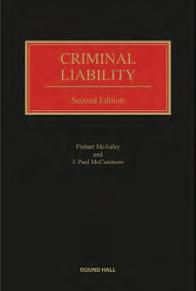
Criminal Liability (2nd Edition)
Finbarr McAuley and J. Paul McCutcheon, 2022, 1,666 pages, Round Hall, €210

Consumer and SME Credit Law
Nora Beausang, 2021, 2,560 pages, Bloomsbury Professional, €325
6 the Parchment
Keith Walsh solicitor and SC practises in the area of family law in Dublin where he is a partner in Keith Walsh Solicitors LLP

Irish Securities Law
Paul Egan SC, 2021, 720 pages, Bloomsbury Professional, €215

Medical Negligence Litigation (2nd Edition)
Michael Boylan, 2022, 448 pages, Bloomsbury Professional, €195

Essentials of Irish Law
Mary Faulkner and Dáithi
Mac Cárthaigh, 2022, Clarus Press, €45
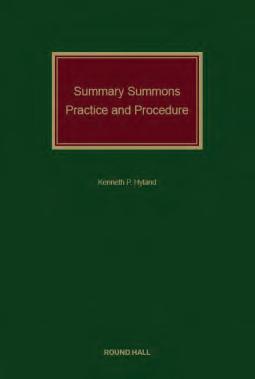
Summary Summons
Practice and Procedure
Kenneth P. Hyland, 2021, 442 pages, Round Hall, €175

Criminal Procedure in the Circuit Court
Matthew Holmes, 2022, 606 pages, Round Hall, €273

Succession Law, Christopher Lehane, 2022, 1,144 pages, Bloomsbury Professional, €275
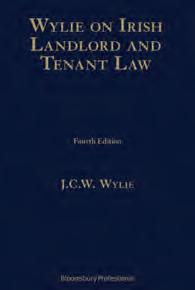
Wylie on Irish Landlord and Tenant Law (4th Edition)
J.C.W. Wylie, 2022, 1,008 pages, Bloomsbury Professional, €295

An Introduction to Irish Company Law
Gráinne Callanan, 2021, 500 pages, Clarus Press, €59
B. Practical Law Book of the Year

Arthur Cox Employment Law Yearbook 2020 & 2021
Arthur Cox, 2021, 536 pages, Bloomsbury Professional, €99
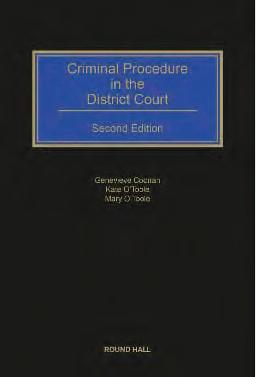
Criminal Procedure in the District Court (2nd Edition)
Genevieve Coonan, Kate O’Toole and Mary O’Toole, 2022, 1,018 pages, Round Hall, €191
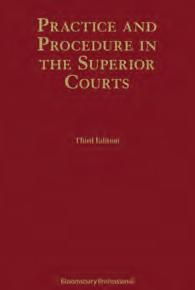
Practice and Procedure in the Superior Courts
Benedict Ó Floinn, 2022, 2,688 pages, Bloomsbury Professional, €295

Civil Litigation of Commercial Fraud
Arthur Cunningham, 2022, Clarus Press, €249

Drunken Driving (2nd Edition)
David Staunton, 2021, 586 Pages, Round Hall, €213

Medical Inquests
Roger Murray, Doireann O’Mahony and David O’Malley, 2022, Clarus Press, €75
Book Awards
Spring 2024 dsba.ie the Parchment 7
Law on Domestic Violence Book Launched
Dublin Solicitor Keith Walsh has co-authored the leading book in Ireland on domestic violence law in Ireland. The former DSBA President and former editor of the Parchment is the co-author of Domestic Violence – Law and Practice in Ireland which was launched recently by the Attorney General, Rossa Fanning. Barrister Sonya Dixon co-wrote the impressive new book
Launching the book, Attorney General Rossa Fanning SC said: “Keith is, as you all know, one of the most prominent family law solicitors in the jurisdiction and is a ubiquitously cheerful presence at DSBA and Law Society events. He is an impressive and frequent contributor to public debate on these topics and was the first family law solicitor in private practice to be awarded a patent of precedence.”
Managing Partner of Keith Walsh Solicitors LLP, Keith is a native of Ballinrobe, County Mayo and qualified as a solicitor in 2001. He has since become the pre-eminent advocate in the country on divorce and family law.
The Attorney General paid tribute to barrister and co-author Sonya Dixon BL, saying: “Sonya has been in practice for almost two decades and over that time has developed a significant family law practice. She has lectured extensively in the field and has previously cowritten a Handbook in Relation to Pensions for family law practitioners, so this is her second important foray into publication in the family law context.”
District Court President Judge Paul Kelly wrote the book’s foreword and said that each day in Dolphin House, there are a queue of people, mostly women, waiting to make ex-parte applications for protection orders. He said that was ‘an indication of how prevalent the problem is’ of domestic violence and he pointed to an increasing trend of parents applying for domestic violence orders against adult children. “It beholds the justice system and the District Court, to whom the overwhelming majority of those applications are made, to be able to deal with them as expeditiously, as compassionately, as sensitively and as accurately as possible.”
The book provides a comprehensive overview of the Domestic Violence Act 2018, with analysis of all measures contained in the Act and procedural developments including new crimes of forced marriage and coercive
control. It also explores the related criminal legislation concerning victims of crime and other criminal legislation dealing with related offences.
Speaking at the book launch which took place at Blackhall Place in front of a large gathering, the Attorney General said that, unfortunately, the topic of the new work could not be of greater significance to the lived experience of thousands of Irish citizens. “Globally, it has been estimated that one in three women are likely to experience violence at the hands of their partner or another perpetrator. No community is unaffected. No class is immune. Published research suggests that incidence of domestic abuse only increased during the Covid-19 pandemic, where persons were often increasingly isolated from support networks and in prolonged proximity to perpetrators.
“There was a measurable 25% increase in criminal charges for breaching domestic violence orders in 2020. In the same year, An Garda Síochána reported a 16% increase in call-outs to domestic violence incidents, with around 43,000 calls registered.
“At the very start of the book, the authors observe the reality that ‘domestic violence cases are difficult cases for all involved, not least because of the subject matter’. This book traces the important changes introduced by the Domestic Violence Act 2018, and the lived experience and practice of wider legislative framework across this country, but it goes significantly beyond that. The authors critically analyse modern legislative reforms and usefully set the current Irish legislative approach against the backdrop of a more international context. The authors also devote a significant part of the text to suggested further reforms of the law in this area.
“Their approach recognises that to stand still in this area is actually to fall behind, and their discussion of the topic certainly provides food for thought as to whether further legislative change is warranted,” commented the Attorney General.
8 the Parchment





the Parchment 9 Book Launch Spring 2024 dsba.ie
Above: Keith Walsh SC, Attorney General Rossa Fanning SC, Soyna Dixon BL and Judge Paul Kelly, President of the District Court
Left: Aine Hynes SC and Michael Hayes
Far left: Judge Kathryn Hutton, John O’Donnell SC, Judge Marguerite Bolger
Right: Olive Doyle and Diego Gallagher
Far right: Patrick Murphy BL and Keith Walsh SC






Married to Solicitor Moira O’Connor from Headford, Co. Galway, Keith Walsh and his co-author Sonya Dixon BL have provided an invaluable guide for solicitors, barristers, judges, social workers, individuals and rights groups and organisations seeking a practical and easily digestible explanation of recent case law and changes in this area of the law, such as the protections now available to victims of domestic violence including giving evidence by live television link.
Walsh is a former chairperson of the Law Society’s Child and Family Law Committee and a fellow of the International Academy of Family Lawyers.
Attorney General Fanning concluded his address by noting that political agreement was reached in February on an EU Directive on combatting violence against women and domestic violence. “This was a long-awaited milestone, with the Government having sought to constructively engage in the negotiations towards the finalisation of this Directive as far back as June 2022. The Directive provides a comprehensive legal framework to tackle all types of violence against women, and sets new standards for protection, support and cooperation amongst Member States.”
A large gathering of colleagues, Judges and members of the legal profession were in attendance for the book launch on the 10th April at the Law Society’s headquarters at Blackhall Place. Speakers at the auspicious event also included President of the District Court, Judge Paul Kelly, co-author Sonya Dixon BL and Keith himself. The book is published by Bloombury Professional. P
10 the Parchment
Ms. Justice Nuala Jackson, Margaret Farrelly BL, Oisin Crotty BL and Dymphna Devenney BL
Sonya Dixon BL, Senator Vincent P. Martin SC and Keith Walsh SC
Right: Ms. Justice Nuala Jackson, Marian Moylan, Tabitha Wood BL
Far right: Attorney General Rossa Fanning SC and President of the District Court Judge Paul Kelly Right: Authors Keith Walsh SC and Sonya Dixon BL
Far right: Padraig Whelan and Hilda Clare O’Shea








the Parchment 11 Book Launch Spring 2024 dsba.ie
Left: Mary Hallissey and Judith Tedders Far left: Ms. Justice Nuala Jackson, Michael O’Connor SC, Ms. Justice Leonie Reynolds and Attorney General Rossa Fanning SC
Left: Anna, Kate and Rory Walsh Far left: Marian Berry BL and Niall Buckley SC
Right: Michelle Ni Longain, Barry McCarthy, President of the Law Society and Richard Hammond SC Far right: Ken Breen, Elaine Given and Hilda Clare O’Shea
Left: Shane Coyle, Ciaran Dunne, Graham Kenny and Parchment Editor John Geary Far left: Tony O’Sullivan and Colette O’Malley
Last Line of Defence
The Parchment’s Killian Morris met with Matthew Kenny, President of the DSBA and Partner in O’Sullivan Kenny Solicitors, for a broad-ranging discussion on his career to date and being at the helm of the DSBA
The DSBA’s first citizen is leading the fight to restore the pay for solicitors doing criminal legal aid work. “I don’t agree with some solicitors who think we need to be quiet about the fact that we want pay restoration,” he says when articulating how he thinks solicitors need to do more to advocate for decent pay for their work. He mentions with some pride the successful ‘Kenny Shoes’ business established by his grandfather and continued by his father, pointing out “my dad used to make a living selling shoes. When people bought a pair of shoes, they paid for them. It’s the same when you go to a doctor or a dentist.”
The restoration of pay for criminal legal aid solicitors is top of the agenda for Matthew during his tenure at the helm of the DSBA. We discuss how the pay for solicitors practising in this area is still 30% below the levels paid prior to the financial crisis. He points out that this work, being carried out by so many solicitors throughout the country, is crucial to a functioning society. “The State has a legal obligation to provide legal aid. It has no choice – it is the same as having to provide public medicine. We don’t have a public defender system like in the United States. We outsource it to private defence solicitors, such as myself and others, in the towns and cities around the country. There is no question of the politicians voting for a public defender system. They have done the sums, and the private provision of legal aid is far more cost-effective.”
While we cannot condone or promote anybody breaking the law, I think we need to do something so that we can have a unified voice but not be in breach of competition law
Clearly Matthew and his criminal defence colleagues have had enough, but the constraints of competition law have made this fight a difficult one. The legislation restricts competing businesses from acting together in relation to the pricing for their services, but Matthew believes they need to be imaginative and come up with solutions to this: “While we cannot condone or promote anybody breaking the law, I think we need to do something so that we can have a unified voice but not be in breach of competition law. We need the full 30% [reduction] to be restored and that is just so we can continue to provide the service.”
He points out that, particularly outside Dublin, the provision of this legal service is no longer economically viable for some solicitors. He mentions how, in some parts of the country, there may, in the future, be no solicitors available to step forward at important times, such as to attend Garda Stations for interviews ‘out of hours’. For those of us not involved in criminal legal practice, he explains how he might be called out on a Saturday or Sunday to a Garda Station, to assist somebody he has never met, for the princely sum of €93 for the first hour. Despite this and the fact that he has built a strong private practice (and not reliant on legal aid work), he still responds to the call when it comes through. He notes that, in most of these situations, the advice/ assistance needed by a person in custody
12 the Parchment
Cross Examination

Spring 2024 dsba.ie the Parchment 13
Killian Morris is a partner at AMOSS LLP and a member of the DSBA Parchment committee

If you are good at what you do and you work hard, the work will always come but if you take somebody short you might be fine but more likely you will have a less enjoyable work life
is “probably the most important piece of advice they're ever going to get in their life”. It is clearly unfair that government has consistently refused to recognise this.
The Gardai, he points out, will also be badly affected if people are unwilling to do this work anymore. What happens, for example, if they can’t find a solicitor who is prepared to come down to the station to do an interview for a murder or a sexual crime?
The whole system would grind to a halt in that situation, where the accused person can’t be questioned – “this not only compromises the Gardai in doing their job but also in the vindication of victims’ rights,” he says.
Further, we speculate that, to the extent that solicitors may be happy to work at these
rates, these are likely to be junior or newly qualified solicitors who will not have the requisite experience to properly represent the accused person’s interests. Clearly this could create the worst of all worlds, where the quality of representation is diminished to levels associated with an American-style public defender system, whilst still operating under the umbrella of the apparently better Irish system of private provision of criminal legal aid. Matthew feels the main reason government hasn’t reacted to these demands is because solicitors haven’t properly organised or mobilised in response to the situation.
Getting paid for an honest day's work is something that was drummed into Matthew
Kenny as a trainee/apprentice in Sheehan & Partners, in the early 2000s. He recalls one of the partners, Bobby Eagar, as being great at sitting down to explain the economics of the practice of law. On one occasion, when trying to impress his senior colleagues, Matthew remembers deliberately speaking loud enough on the phone to a prospective client, so the entire office could understand how much he knew about a particular issue! Later on, and far from being impressed, Bobby sat the young Matthew down and explained to him that he was better off not sharing such valuable advice without ensuring he was going to get paid for it.
Matthew spent 13 years working in Sheehan & Partners – first as an intern, then as an apprentice through to qualification, and ultimately as a partner, until his departure in late 2015. When leaving UCD, he didn’t have any particular desire to have a career in law and had been working in a thriving online hotel reservations business. Then, when his housemate, Jessica Goldrick (now solicitor with KOD Lyons), was doing her FE-1s, Matthew decided to give it a go himself. He really enjoyed studying legal subjects, more so than anything he had studied before. He says he liked criminal law, contract law and even equity. However, when he finally had all his FE-1s completed, he found it very difficult to get an apprenticeship, as he knew he wouldn’t be suited to one of the big firms.
As it happened, Matthew managed to secure a one-month internship in Sheehan & Partners, having been told, in no uncertain terms, that there were no apprenticeships available. Attending court on his first day, Matthew immediately realised criminal defence work was his true calling and he set about making himself indispensable around the office. After two months, Peter Mullan (one of the partners) agreed to take him as his apprentice.
He is proud to have had such great mentors over the course of his career to date, including Peter, as his master, but also the other partners in the firm. He singles out Garrett Sheehan as being such an influential figure generally across the profession and notes that he was held in such high esteem by the partners in the office and everybody he dealt with. “He was brilliant. He was the perfect advocate, he knew that ‘less was more’, he knew when to say something and not to say something. His work rate was ‘off the charts’ and this seeped down to everyone else in the firm who would be at their desks at 7.30 in the morning because they wanted to be,” he recalls fondly.
Growing up in Rathmines in Dublin with his three siblings, Matthew’s mother was to go on to become a Presbyterian Church of Scotland Minister. With his father having
14 the Parchment
Photography: Bryan Meade
sold the shoe business, the Kenny family emigrated to Edinburgh when Matthew was 12. He completed his second-level education in Scotland but, missing Dublin, he then returned to UCD in 1997 to study history and politics. He was involved in debating in both the Law Society and the L&H and remembers current Attorney General Rossa Fanning being one of the adjudicators on the night of his maiden speech.
Now working in his own firm, post Covid-19, Matthew is happy with his work life balance: “One of the main reasons I set up on my own was I wanted to see my son Patrick grow. He is 12 now. So, I take every Friday afternoon off and it has worked out great.” He is particularly busy Monday through Wednesday and then, unless he has a trial on, he takes Thursday to plan the week ahead. He enjoys hiking, swimming and running, and loves watching football. His new year's resolution this year is ‘to put down the phone’ and read more books. At the moment, he is reading “The Buried Giant” by Kazuo Ishiguro and has rejoined Rathmines library – “I have this habit of buying new books but never reading them, so the library is probably a good idea!” he says.
Matthew isn’t sure that Patrick will follow in his footsteps as a lawyer, but he can certainly be very proud of what his dad has achieved. In setting up his own firm in 2016, Matthew and his partner Mark O’Sullivan have built an enviable practice with a good private client base. “When I left Sheehans, I wanted to work for myself. I had agonised over it for a couple of years before making the decision. It was so hard to leave, as they treated me so well, and I enjoyed going to work there. But I knew I needed to be the boss.” After a brief stint as a sole practitioner, Matthew realised he didn’t enjoy being completely on his own, particularly with the early stress of wondering whether enough work would come in the door. Mark O’Sullivan, a criminal defence colleague, was himself looking for office space and Matthew was only too happy to oblige. Within a couple of months, they were getting on well, covering each other’s work, so it made sense to form a partnership. They have been operating as O’Sullivan Kenny ever since.
Matthew has been involved in the DSBA since 2012 when Keith Walsh was president of the association. At that point, the DSBA Criminal Law Committee was at a low ebb and needed to be re-established. Keith had reached out to Sheehan & Partners to see if they could assist, and they put Matthew forward for the role. Initially, he felt he was too busy with work and life generally and he didn't feel the need to get involved. He met up with Keith and started attending events and realised there was something to it. He

enjoyed the social side of the DSBA and, he admits, as a criminal defence solicitor, it isn't often that you interact with or socialise with colleagues you are normally competing with for business. He notes with disappointment that things have been difficult between some criminal law colleagues but having an outlet like the DSBA has been a valuable tool in trying to break down barriers and defuse situations.
Which brings us to the number one theme of Matthew’s year in office – the promotion of collegiality amongst Dublin solicitors. “You need to look at the bigger picture,” he says. “Clients come and go but you will have your colleagues throughout your career. If you are good at what you do and you work hard, the work will always come but if you take somebody short you might be fine but more likely you will have a less enjoyable work life.” This, he thinks, is the number one benefit of an organisation like the DSBA: when people work alongside each other, they get on better, which can only help.
When I ask him about advice he would give to younger members of the profession
he remembers how he cringes a little bit when he thinks of how he would operate as a newly qualified junior solicitor. “I was too aggressive in court and I was too aggressive in the Garda Station,” he says. “I think it comes from not knowing what you're doing and it comes from being ‘scared’ because you're not really sure what you're doing is right. But then, the longer you're qualified, in my opinion, you should become far more removed from the job you do.” Nowadays, he deals with even the most contentious situations with calm, knowing that antagonising others working in the system, be it judges, Guards or other colleagues, can only make life more difficult for him and his clients, in the long run.
We talk about the other challenges facing the profession and he mentions the recent controversy around enduring powers of attorney. The process of making an enduring power of attorney, which had been working well, has been brought online in an apparent attempt to marginalise the role of solicitors to the detriment of often vulnerable clients. Again, as with the campaign to restore pay, there doesn't seem to be much sympathy for
Cross Examination
Spring 2024 dsba.ie the Parchment 15

I don't think we should want to be popular because our job is not to be popular. Our job is to do a job for our clients. We should be like a referee in a good football match: be seen and not heard!
solicitors on this issue, either in government or from the public. He believes that many of these public relations difficulties are compounded by the poor relationship between us and the media. Matthew believes that, to a large extent, we are burdened by our professional duties of confidentiality – “other than in general terms, journalists don't appreciate that and they think that we're
being difficult, that there’s some sort of a lack of transparency in our profession. Actually, we're one of the few professions that choose to regulate ourselves and do so to a level which is actually quite a burden for a lot of people in our profession. But we choose not to engage with journalists because, almost always, it's not in our client’s best interest.” We talk about whether there is a solution to this and, ironically, he doesn’t
think we should be striving to be more popular: “I have to say I think it's a dangerous, dangerous step to take [to try to be popular with the media]. I don't think we should want to be popular because our job is not to be popular. Our job is to do a job for our clients. We should be like a referee in a good football match: be seen and not heard!”
Halfway through his presidential year, Matthew is clearly enjoying his time at the helm of the country’s largest bar association. Advocating for colleagues on important issues and going around the city and country meeting with colleagues reminds him of why he first got involved in legal politics. Of course, the day job isn’t suffering and, while I hope never to require his professional services – I know I would be in good hands if I did. P
16 the Parchment
Have you searched for the Deceased’s Will?

Ensure you administer the estate correctly with...

Prices start as low as €79 (+ VAT) for a standard Will search
Start your search today at
www.willfinder.ie



•3 Nights in the 5* Gran Hotel Domine Bilbao
•Welcome Buffet Dinner at the Gran Hotel Domine with wine on Thursday 19th September
•Optional tour to La Rioja wine region with lunch
•Business session at the Biscay Bar Association
•Optional group dinner on Friday 20th September
• Optional tram & walking tour of the old town of Bilbao

• Gala Dinner with wines at the Sociedad Bilbaina


€1,095 per person sharing
Visit the 2024 Annual conference link on the DSBA website www.dsba.ie to view
Conference Brochure & Booking Form



Now Limited Availability
Book

Probate Tips
Padraic Grennan of Erin International gives some practical tips for probate applications – and how to ensure yours gets finalised quickly
Probate as a process is slow. For a multitude of reasons, it wouldn’t be unusual for the administration of an estate to take in excess of two years. Such time frames can cause undue frustration and anger among solicitors, their clients and beneficiaries.
During a recent conversation, one extremely frustrated practitioner expressed his disillusion to me over the delays in grants of representation being issued. Why does it take five months to look at his file, only for it to be rejected over a very minor clerical error? This attitude reflects the general feeling among many practitioners nationwide, who are under pressure from their clients to close out estates and distribute. The waiting times are understandably frustrating. But who, if anyone, is to blame, and what can be done?
Two Sides of the Coin
Taking a holistic view, we need to look at both sides of the coin here.
On one side we have the Probate Office, the main function of which is to issue grants of representation. Although it offers a (by all accounts very effective) support service to personal applicants, it is not an advisory service for solicitors. With the closure of the Seat Office, the option to meet in person to discuss file-related queries is now gone. Phone queries are limited, again because the focus is on assessing applications, issuing grants and placing all available resources towards carrying out this function.
The Probate Office is currently fully staffed. A number of the resources are responsible for the assessment of Solicitor Applications, with some further resources being responsible for the Personal Applicant section. Between both the solicitor applications and personal applicant applications, there are between approximately 10,000 and 11,000 grants issued in the Dublin Probate Office per annum. Based on this figure alone, I think it’s fair to say that this team is not slacking.
If you know probate, you’ll know it’s rarely straightforward and only time and experience teach one how to navigate the unique nuances of each individual case. Marry that with the newly introduced mobility initiative (where civil servants can apply for a lateral transfer from one department to another), and the departure of a number of highly experienced senior staff members within the past 3-4 years, and you’ll begin to understand the challenges faced by team Probate Office.
On the other side of the coin is the practitioner. Given the high rejection rate, some level of responsibility has to be taken for the quality of applications being submitted. The reality is grim. Approximately 60% to 70% of applications are rejected on the first submission attempt. This is old news as this figure seems to have remained the same for a number of years.
On top of the constant influx of new cases that need to be assessed, Probate Office staff also have to check a steady flow of resubmissions, many of which are
20 the Parchment

rejected a second or third time. These ‘resubmits’ will then work their way back into the queue for further assessment and eventual approval.
Facts
Given the persistent delays, it is important that practitioners understand what exactly is going on. Below are some pointers that will hopefully dispel any probate application misgivings.
• It’s currently taking between 16 and 18 weeks for your application to be assessed (note that these waiting times apply to the Dublin office only, and that regional registries may have reduced waiting times). All applications are logged in order of date of receipt and will sit in a queue for 4-5 months before they are opened and examined for the first time.
• If errors exist, your application will be queried and, in some cases, rejected, and some or all of your papers are returned to you. When you resubmit, your file joins the “resubmitted” queue, which contrary to common belief, only takes 2-3 three weeks to process.
• The Probate Office staff want to issue grants. They do not want to be returning your papers but must do so if the application is incorrect. It is not their responsibility to correct any errors.
• The Seat Office is closed and will remain so for the foreseeable future. The harsh reality is that to man a public office where general enquiries are fielded, means diminishing a team whose purpose is to assess applications and to issue grants.
Main Reasons for Rejections
The vast majority of rejections boil down to very simple errors being made prior to submission. A lot of the queries could be avoided if a little more care was applied before the applications are lodged. The following are examples of reasons as to why an application might be queried and/or rejected.
No or Incorrect Title:
This may seem obvious, but if the title is incorrect, it follows that your entire application will be wrong. This means that you have not clearly set out in your oath your client’s legal entitlement to extract a grant in your oath.
The Probate Office will not assess applications where the applicant is not showing their correct entitlement to the grant. The file is returned marked “No Title”, and the rest of the papers will also have gone unchecked.
Jurats:
A faulty jurat is one of the top three reasons why probate applications are returned. It may happen that your application has been checked but a badly completed or incomplete jurat prevents the application from progressing.
A jurat must be signed by the applicant before a commissioner for oaths or a solicitor, on a particular date, at a particular place. The applicant must be known to the solicitor/commissioner, identified by a third party (who must sign the jurat and certify as to
The vast majority of rejections boil down to very simple errors being made prior to submission. A lot of the queries could be avoided if a little more care was applied before the applications are lodged
the Parchment 21 Probate Spring 2024 dsba.ie
International
Padraic Grennan is the Chief Executive at
Erin
Probate
The introduction of a new digitaloriented system will hopefully mean that Ireland can bring itself in line with other jurisdictions where grants of representation issue more expeditiously
their knowledge of the deponent) OR the deponent must be identified by means of an official document e.g. a passport or driving licence. The reference number and type of document must be indicated. (See S.I. 95 of 2009).
General Inconsistencies:
Another major reason for rejections is a lack of consistency across the application. Simple errors are being made where details on one document do not match the details on another. Practitioners are encouraged to thoroughly proofread their applications prior to submission so as to ensure any minor errors are spotted in advance. This can often be the difference between the application progressing and your grant issuing, and your application being queried and/or rejected.
The Future: e-probate
In light of the obvious shortcomings in the current system, one cannot but wonder if a digital system would expedite probate and shorten the waiting times. This, thankfully, is in the works.
As part of the Courts Modernisation Programme, an e-probate project is now underway. Funding has been approved and a project board has been established to develop an online probate system. Additional resources have been assigned to the office as part of the e-probate project. The project is still at the planning stage, but it is hoped that the first version of an online probate system will be launched in the first quarter of 2025.
The basic idea of the e-probate platform will be to digitise the collection of most of the information
required for a probate application. Practitioners will register for and gain access to a secure online portal, similar to Revenue’s SA2 platform, where they can enter the data as required throughout the probate process. Original wills and death certificates will still need to be lodged with the Probate Office, but it is hoped that everything else will be submitted digitally.
The new system will be applicable to deaths that occur post 5th December 2001, and any applications where deaths occur prior to this date will be processed by physically lodging the entire application, as is the current norm. It will also contain an in-built title checker which will require the applicant to answer specific questions, thus preventing them from proceeding until the title is deemed correct.
E-Probate will be a revolutionary change in the probate process, and it is hoped will significantly reduce the errors and waiting times. The introduction of a new digital-oriented system will hopefully mean that Ireland can bring itself in line with other jurisdictions where grants of representation issue more expeditiously.
Until then, we as stakeholders have to be content with working within the confines of the current regime, which, while not perfect, is certainly robust in ensuring that grants issue to those entitled to extract, and in turn lawful beneficiaries receive their rightful entitlements.
As to who is to blame for these constant delays?
Let us not point fingers. It appears that everyone is doing their best under the circumstances. It does seem though that a transition to a more digitally focussed approach makes sense and will hopefully help ease stakeholder frustrations over time.

22 the Parchment
P



















































FREECPD hub.erininternational.com REGISTER NOW!
It is hugely welcome news and essential that the new Family Courts complex is built as soon as possible
Hammond Lane Family Courts get Green Light
The long-awaited and overdue good news that the Dublin Family Courts complex is to proceed arrived recently. The Commissioners of Public Works have granted planning permission for the 19-courtroom Family Courts complex which is to be built on the brownfield site located at Hammond Lane/ Church Street in Dublin 7 adjacent to the Four Courts
The DSBA has campaigned and lobbied tirelessly for almost a decade to have the Hammond Lane project advanced. Family lawyers, court staff, judges, witnesses and litigants have been waiting in unsuitable court accommodation. This is great news for all court users.
Conditions at the existing central Dublin family court venues at Dolphin House, Chancery Street and Phoenix House are basic, with problems of overcrowding, lack of privacy, inadequate waiting areas and an absence of child and family friendly spaces all adding to the stress of participating in Family Law proceedings.
Writing in the spring edition of the Parchment in 2022, leading family law solicitor Keith Walsh said: “We still await a sod being turned on the new Hammond Lane Building. Childcare in Dublin is still being run from

nineteenth century courts set up to deal with criminal and civil cases and the family law lists around the country are bursting with cases, many of which will not be reached. We can but hope that family law will at some point move from being the poor relation to the prodigal son or daughter.”
In May 2019 the Irish Examiner reported the then Chief Justice Frank Clarke’s views on the condition of the family courts in Dublin. Mr. Justice Clarke told the government that the family law courts in Dublin required “the most urgent attention” and operated in “dreadful conditions”. He said of Dolphin House that “the office block carved out of the remains of the old Dolphin Hotel provides wholly unsuitable facilities for what are inevitably difficult and delicate cases”. He said many other premises in Dublin being used for family law were “not much better”. In a typically memorable phrase, he also said: “Hammond Lane is, as they say, shovel-ready, subject to planning, and planning is ready to go once funding is in place.”
That was five years ago, and those shovels now look to be finally getting ready. It is hugely welcome news and essential that the new Family Courts complex is built as soon as possible to meet the demands and pace of the high volume of family cases before the Dublin courts.
The Courts Service has warmly welcomed news that planning permission for Hammond Lane Family Law Centre has got the green light. A spokesperson for the Courts Service said: “The Dublin Family Courts complex will replace the current fragmented and inadequate facilities with a modern, purposebuilt facility where family law cases can be held in a dignified, secure and non-threatening environment. Court facilities will be provided in an integrated complex alongside mediation, family support and related services.”
The National Development Finance Agency (NDFA) is now expected to procure and deliver the Dublin Family Courts complex in conjunction with the OPW, on behalf of the Courts Service, as a Public Private Partnership.
It is anticipated that construction will commence during 2026 and complete in 2028. P
24 the Parchment Family Law/News
Personal Injuries Supreme Court Ruling
The highly anticipated judgment in the case of Brigid Delaney -v- Personal Injury Assessment Board, The Judicial Council, Ireland and the Attorney General was delivered recently amid much expectation.
The seven-judge court delivered five separate judgments (with the remaining two judges concurring with two of the delivered judgments) but Ms. Delaney ultimately lost her appeal, and the Court upheld the Personal Injuries Guidelines as valid.
In a statement by Justice Minster Helen McEntee, she said: “The Supreme Court’s decision was both very significant and very welcome, upholding, as it did, the personal injury guidelines which were adopted on my watch back in April 2021.
That is really good news because we really believe these guidelines are key to our plan to make insurance more affordable.
“I think in the past we all felt uneasy at some personal injury payouts. No one wants to see a person badly injured left without adequate compensation, but at the same time, we were aware of very high payouts for many quite small and even insignificant injuries.”
The Justice Minister continued: “While the court upheld the guidelines, it has identified deficiencies in the underpinning legislation which will have to be fully considered by my officials with the advice of the Attorney General. I will bring forward any necessary amendments to the legislation in light of that consideration.
A majority of Supreme Court judges recently held that the relevant section of the Judicial Council Act 2019 is unconstitutional, but that the Personal Injuries Guidelines are nonetheless binding because they had effectively been ratified by the Oireachtas in a separate 2021 Act P
“The guidelines were introduced to help standardise awards for common injuries. That introduction was challenged, but today, in a complex judgment by the Supreme Court, they were upheld.
“Meanwhile, we will also keep a close eye on the impact of reduced awards under the guidelines, as we want to make absolutely sure that they are reflected in reduced premiums.”

the Parchment 25 Personal Injuries/News Spring 2024 dsba.ie

Recent Developments in Employment Law
How many different types of leave are employees in Ireland potentially entitled to? A good quiz question for certain select gatherings! Varying leave entitlements and other entitlements for employees have recently been introduced, significantly changing the employment landscape that all employers should be aware of. Ciara O’Kennedy gives her overview on recent employment law developments
Extension of Statutory Obligations under the Protected Disclosures Legislation
The scope of the protected disclosures legislation was extended on 17 December 2023 from employers with 250+ employees to employers with 50+ employees. Inscope employers are now obliged to establish internal reporting channels and procedures in their workplace for the making of a protected disclosure.
In summary, employers are required to ensure that secure channels are in place for receiving a protected disclosure and to acknowledge receipt of the disclosure within seven days. A designated person or persons within an organisation must be appointed to undertake this role. This person is responsible for providing feedback to the discloser and must keep the discloser informed of the progress of the investigation and the outcome no later than three months from receipt of the disclosure. A failure to establish, maintain and operate the reporting channels and procedures may lead to significant fines and penalties being imposed, ranging from €75,000 to €250,000, and/or imprisonment for up to two years.
There is no obligation to accept and follow up on anonymous complaints, but an employer may choose to do so.
The Government published updated Statutory Guidance in November 2023 for public bodies and prescribed persons under the Protected
Disclosures Act 2014, as amended, which can be viewed at https://www.gov.ie/en/publication/ e20b61-protected-disclosures-act-guidance-forpublic-bodies/?referrer=http://www.gov.ie/protecteddisclosures. Whilst aimed at public bodies, the Guidance is useful for all employers who come within the scope of the legislation.
Employers who fall within the scope of the legislation should look to update their whistleblowing/ protected disclosures policies as soon as possible if they have not already done so.
Leave Entitlements
Domestic Violence Leave
Domestic violence leave, introduced by the Work Life Balance and Miscellaneous Provisions Act 2023, is a new type of leave that came into force on 27 November 2023. It provides for five days paid leave for an employee who is suffering, or has suffered, domestic violence, in any period of 12 consecutive months, at their full rate of pay. There is no minimum service requirement to avail of this leave and employees will not be obliged to produce evidence in support of their application for leave. It is, however, acceptable for an employer to seek sufficient explanation from the employee in order to ascertain if an entitlement to domestic violence leave arises.
26 the Parchment

The intention of the leave is to enable the employee (or a ‘relevant person’ as defined under the legislation) to seek medical assistance, obtain support services and counselling, relocate either temporarily or permanently, seek legal advice or assistance, seek assistance from an Garda Síochána or to obtain a safety or barring order from the courts.
Parent’s Leave and Parent’s Benefit
It was announced in Budget 2024 that Parent’s Leave and Parent’s Benefit will be extended from seven to nine weeks of leave from August 2024.
Parent’s leave is available to employees who are a ‘relevant parent’ (e.g., a parent or adopting parent of a child; or a spouse, civil partner or cohabitant of the parent of the child; or a spouse or civil partner of the adopting parent of the child) and whose child was born or adopted on or after 1 November 2019.
Parent’s leave is available to each parent and there is no minimum length of service requirement for parent’s leave. The leave, which may be taken in one continuous block or as two separate blocks (of no less than one week), must be taken within the first two years of the child’s birth or adoption. There is no obligation on the company to pay an employee on parent’s leave, but an employee may be entitled to the State Parent’s benefit, provided the employee has sufficient PRSI contributions.
Statutory Sick Pay (SSP)
The Sick Leave Act 2022 came into force in January 2023 on a phased basis. The leave entitlement from 1 January 2023 was three days and was then increased to five days on 1 January 2024. It is intended that it will increase to seven days in 2025 and ten days in 2026.
SSP is provided to all employees at a rate of 70% of their wage but subject to a daily threshold of €110 per day. It is expected that this maximum cap may change and be amended over time to take account of changes in income and inflation. It applies to all employees with continuous service of 13 weeks or more.
The entitlement to sick leave applies from the first day of absence and does not need to run consecutively. To avail of statutory sick leave, employees are required to furnish a medical certificate from a registered medical practitioner covering each day of absence and stating that the employee is unable to work.
Employers who already operate a sick leave scheme are exempt from the obligations provided for under the Act where they can show that existing company benefits are as favourable or more favourable than the statutory entitlement.
If an employer fails to provide statutory sick pay, then an employee who submits a complaint may be awarded four weeks’ pay in addition to their statutory sick leave entitlement.
Where an employer maintains it cannot afford to
the Parchment 27 Employment Law Spring 2024 dsba.ie
Ciara O’Kennedy is a partner in the Litigation and Dispute Resolution Team at LK Shields. She is chair of the DSBA’s Employment Law Committee
Where an employer maintains it cannot afford to discharge its sick pay obligations, an exemption can be granted by the Labour Court, but availing of this exemption will require an employer to establish that it is suffering severe financial difficulties
discharge its sick pay obligations, an exemption can be granted by the Labour Court, but availing of this exemption will require an employer to establish that it is suffering severe financial difficulties.
In the recent case of Katerina Leszczynska v Musgrave Operating Partners ADJ-00044889, the WRC examined for the first time an employer’s obligation to pay SSP and the circumstances in which a company sick pay scheme is exempt from the obligation to pay SSP. The WRC found that employers who have company sick pay provisions that are more favourable to employees than the statutory sick pay will not be affected by the legislation. In assessing whether sick pay provisions are on the whole more favourable, the WRC took into account the following factors:
• The period of ser vice of an employee before sick leave is payable.
• The number of days that an employee is absent before sick leave is payable.
• The length of time for which sick leave is payable.
• The amount of sick leave payable.
• The reference period of the sick pay scheme.
The Work Life Balance and Miscellaneous Provisions Act 2023 introduced other additional leave entitlements:
• Employees are entitled to up to five days unpaid leave for medical care purposes.
• Transgender men (who have given birth) can now access maternity and pregnancy related leave and entitlements.
• The number of weeks during which mothers are entitled to take paid time off work for breastfeeding purposes has been increased from 26 to 104.
The right to access to these entitlements has been in force since 3 July 2023.
Right to Request Remote Working & Flexible Working Arrangements
The right to request remote working arrangements and flexible working arrangements for caring purposes have finally come into force in Ireland following the recent publication of the long-awaited Code of Practice.

In brief, Part 4 of the Work Life Balance and Miscellaneous Provisions Act 2023 (the “Act”) required a code of practice, and the Workplace Relations Commission (“WRC”) has now published that Code of Practice on the Right to Request Remote Working and the Right to Request Flexible Working Arrangements. The Code provides practical guidance for employers and employees regarding compliance with the requirements of the Act in relation to applications made by employees for remote working or flexible working arrangements. Employers and employees are obliged to have regard to the Code in respect of all applications for remote or flexible working arrangements and when terminating such arrangements.
Gender Pay Gap Reporting
The Gender Pay Gap Information Act 2021 came into force on 31 May 2022. In June 2022, employers with 250+ employees were required to choose a ‘snapshot’ date within that month, to prepare a report on the gender pay gap (GPG) for the employees in their company on that date and to publish that report in December 2022 and December 2023. GPG reporting initially applied to public and private sector organisations of 250+ employees on the snapshot date in 2022 and 2023, but the scope is set to be extended to organisations with 150+ employees in 2024 and to organisations with 50+ employees from 2025.
An employer will have to report on:
• The mean and median wa ge gap for full time, part time and temporary employees.
• The mean and median bonus gap for full time, part time and temporary employees.
• The proportion of men and women that received bonuses.
• The proportion of men and women that received benefits in kind.
• The proportion of men and women in four quartiles. Specific regulations and guidance apply to how the calculations should be carried out.
Employers are required to publish a statement setting out, in the employers’ opinion, the reasons for the gender pay gap in their company and what measures are being taken or are proposed to be taken by the employer to eliminate or reduce the pay gap. An employee can bring a claim to the Workplace Relations Commission (WRC) in respect of non-compliance with the legislation. The WRC can make an order requiring the employer to take a specified course of action to comply with the GPG legislation, but there are no provisions for compensation to be awarded or fines to be imposed for non-compliance. All decisions of the WRC are published with the parties named.
The legislation does empower the Irish Human Rights and Equality Commission to apply to the Circuit Court or the High Court for an enforcement order where there is suspected non-compliance.
Pensions (Auto-enrolment)
On 29 March 2022, the Minister for Social Protection announced the details of the Automatic Enrolment Retirement Savings System for Ireland, which is to operate on an ‘opt-out’ rather than an ‘opt-in’ basis. The scheme is expected to begin in the latter half of 2024.
28 the Parchment

Auto-enrolment is expected to be gradually phased in over a decade, with both employer and employee contributions starting at 1.5%, and increasing every three years by 1.5% until reaching 6% in by 2034.
The scheme provides that the employer should match the employee contributions up to a maximum of €80,000 of earnings and the State will provide a corresponding top-up of €1 for every €3 saved by the employee up to a maximum of €80,000. That means that for every €3 saved by an employee, a further €4 will be credited to their pension savings account between the employer and the State contribution. All employees who are not already in an occupational pension scheme, aged between 23 and 60 and earning over €20,000, will be automatically enrolled.
National Living Wage
The Government announced the introduction of a national living wage for employees at the end of 2022. The national living wage will be set at 60% of hourly median wages. It will be introduced over a four-year period and will be in place by 2026, at which point it will replace the national minimum wage.
The National Minimum Wage Order 2023 set the national minimum hourly rate of pay from 1 January 2024.
Aged 20 and over€12.70
Aged 19 €11.43
Aged 18 €10.16
Under 18 €8.89
The Payment of Wages (Amendment) (Tips and Gratuities) Act 2022
On-the-spot fines were introduced in late December 2023 for employers who are failing to comply with this Act. In addition, a public consultation on the Payment of Tips was launched in January 2024 to review the impact of the legislation that came into operation in December 2022 and to assess whether any further measures are required in relation to the fair distribution of tips and gratuities.
Thoughts
Employers should be advised to review these developments and consider those that are relevant to their organisations. Changes may be required to ensure compliance with the obligations on employers and the entitlements for employees. That is likely to mean introducing new policies and procedures or amending those that are already in place.
the Parchment 29 Employment Law Spring 2024 dsba.ie P

Navigating the Transition
Mary O’Donoghue of the DSBA In-House Committee outlines some challenges for solicitors moving into In-House Practice
TUnlike in private practice, where the focus is primarily on providing legal advice to clients, inhouse lawyers are integral members of the company, or organisation, involved in strategic decisionmaking and risk management
ransitioning from a private solicitor role to an in-house legal position presents a unique set of challenges for practitioners. While the core legal skills remain the same, adapting to the nuances of in-house practice requires a shift in mindset and approach for individual solicitors. In this short article, some of the key challenges faced by solicitors making this transition and insights into how colleagues overcome them are discussed:
1 Understanding the Business Context
One of the most significant adjustments for solicitors moving in-house is understanding the business context in which they will be operating. Unlike in private practice, where the focus is primarily on providing legal advice to clients, inhouse lawyers are integral members of the company or organisation, involved in strategic decisionmaking and risk management. This shift requires a broader understanding of the organisation’s goals, operations, and industry landscape.
2 Balancing Legal and Commercial Considerations
In-house solicitors often find themselves navigating between legal and commercial interests. While legal advice remains essentially the same, it must be delivered in a way that aligns with the company’s commercial objectives. This requires a delicate balancing exercise as an in-house solicitor must assess legal risks involved while also considering the practical implications for the business that employs him/her.
3 Developing Soft Skills
In addition to legal expertise, successful in-house solicitors must possess strong interpersonal

and communication skills. Building effective working relationships with colleagues across various departments is crucial for providing proactive legal support and integrating legal considerations into business decisions. This will require solicitors making this transition to enhance their collaboration and negotiation skills so as to effectively engage with non-legal stakeholders in this new role.
4 Managing Workload and Priorities
In-house practice often involves managing a diverse workload with competing priorities. Unlike the billable hour model of private practice, in-house practitioners often face tight deadlines and unexpected demands from their employer, requiring them to prioritise effectively and manage their time efficiently. Adapting to this fast-paced environment can be challenging for solicitors accustomed to a more structured and predictable workflow in private practice.
5 Navigating Ethical and Confidentiality Issues
Maintaining ethical standards and confidentiality is paramount for all legal practitioners, but in-house solicitors can face unique challenges in this regard. They may encounter situations where legal advice intersects with business interests, requiring careful navigation to avoid conflicts of interest or breaches of confidentiality. Private practice solicitors transitioning to in-house roles have to familiarise themselves from the get-go with their employer’s protocols for handling sensitive information considering their responsibilities as a member of the Law Society and officer of the Court.
6 Overcoming Challenges through Adaptation and Continuous Learning
While the transition from private practice to in-house practice presents its challenges, it also offers opportunities for personal and professional growth. By actively engaging with business and embracing the dynamic nature of in-house practice, solicitors can successfully navigate this new role with support from colleagues. Continuous learning and a willingness to adapt to these new challenges are key to thriving in the ever-evolving landscape of in-house legal practice.
If you have any suggestions for CPD training you’d like to see offered through the DSBA in-house committee for practitioners please contact the current in-house Chair or any committee members to discuss further. Contact maura@dsba.ie for more information.
30 the Parchment In-House Practice
P
Mary O’Donoghue serves as the vice chair of the DSBA In-House Committee and has over 16 years of experience as a prosecutor in the Office of the Director of Public Prosecutions. Since 2020, Mary has focused her expertise in the area of judicial review in the DPP’s Office


DSBA ANNUAL DINNER 2024
WESTBURY HOTEL FRIDAY APRIL 19 Drinks 7pm Dinner 8pm Black Tie Tickets – €140 or tables of 10 – €1,400 contact maura@dsba.ie

Irish Pre-Nups
Pre-nuptial agreements have long been considered a necessity for the very wealthy only. However, where people are pursuing careers and acquiring assets before considering settling into long-term relationships and marriage, pre-nuptial agreements are becoming more commonplace regardless of whether or not either or both parties are of significant means. Avril Mangan assesses the position
With the world becoming more global, and where in many European and Civil Law jurisdictions couples prior to marriage get to elect whether or not they wish for the assets acquired during the marriage to be deemed community property (or in Irish terms ‘marital assets’), and where Ireland has become a multi-cultural society, people’s expectations around protecting their assets and regulating their affairs have changed. Many couples now are taking a pragmatic view rather than romanticised ideals in respect of managing their marital finances.
To a lesser extent, another factor which has raised awareness of regulating rights when entering a romantic relationship was the introduction of the Civil Partnership and Certain Rights and Obligations of Cohabitants Act, 2010. This Act introduced the concept of a cohabitation agreement. A cohabitation agreement allows people to make a decision as to whether or not their relationship will be governed by the cohabitation legislation and the rights and obligations that could potentially arise under that Act.
As a specialist family law practitioner, enquiries are regularly received by couples getting married in relation to how they can protect assets which they have acquired prior to meeting their partner. This is particularly so where one or both of the parties own property prior to marriage and/or where parties anticipate receiving an inheritance from their parents into the future which they want to protect. Whilst
pre-nuptial agreements are not recognised at law in Ireland and are not enforceable in Ireland, they can be used to show the intention of the parties.
When a couple looks into entering into a prenuptial agreement, issues in relation to how they will manage their money, assets, the funding of the family, the fact of whether or not they are going to have children, all come up in the context of considering the appropriate terms to be included in a pre-nuptial agreement. It is always very surprising, as a family law specialist, how many couples never discuss these fundamental aspects of their relationship and how they will be managed in advance of getting married. Pre-nuptial agreements should always be based on full financial disclosure by each party, usually done in the form of a sworn Affidavit of Means, which means both parties are fully aware of the financial status of the other before getting married. Pre-nuptial agreements also deal with matters relating to the financial support of any dependent members of the family: this means couples have to have a discussion in advance of getting married as to how they see their finances being managed and their requirements and needs being met during the course of their marriage, prior to getting married.
At present, pre-nuptial agreements are not enforceable under Irish law as it is against public policy in this jurisdiction to agree terms which contemplate the end of a marriage. The law in Ireland in this respect could change and there is certainly a strong lobby for change. As such, if there was a change
32 the Parchment

in the law relating to pre-nuptial agreements, then such agreements could in the future be enforceable. At this time there is no way of knowing if any legislative changes in this respect will act retrospectively. In circumstances where we have cohabitation legislation allowing an unmarried cohabiting couple to regulate their affairs and to opt out of the potential obligations arising in the context of a relationship under that legislation, and where our society has become more global and where there is strong societal and political will to reform the current family law structure in Ireland, in my view it should only be a matter of time before pre-nuptial agreements are given legal recognition in Ireland.
As the law presently stands, a pre-nuptial agreement entered into by two people prior to marriage, in circumstances where the marriage subsequently breaks down and legal proceedings issue, may be viewed by an Irish Family Law Court as an indication of the intention of the parties as to how they wished for the financial aspects of a separation to be dealt with. If the marriage breaks down in a relatively short period of time, and there are no children of the marriage, then the Court may be more likely to take cognisance of any pre-nuptial agreement which has been signed by the parties. The longer the marriage is, and where there are children of the marriage, the less influential the terms of any pre-nuptial agreement will be in an Irish Court.
It is important that couples who are considering entering into a pre-nuptial agreement are made aware
that there is a likelihood that a Court could take the document seriously as evidence of intention. Whilst the Irish Courts are not bound by the agreement’s terms, the agreement could potentially have significant persuasive value if the Court were deciding on any matrimonial proceedings before it. Therefore, both parties must be very sure that the agreement truly reflects what they want. The obtaining of specialised legal advice will enhance the agreement’s robustness.
A pre-nuptial agreement is the same as any contract: there must be full disclosure and free will. If a party signs the agreement under duress, then the agreement is voidable.
Generally, assets acquired during a marriage are deemed marital assets. Each party’s entitlement to a share of the marital assets is determined by their contributions, both direct and indirect, to the acquisition of the assets as well as the needs of each party and any children which the parties may have. Generally, only assets which are acquired jointly after the date of marriage will be deemed to be joint marital assets. Any sole property received by either party will generally remain as sole property so long as it remains in the owner’s sole name, in the event of a separation. However, such assets must be disclosed in the context of family law proceedings and will be taken into account by a Court when determining the division of assets. Under divorce, the Irish Courts have to ensure that proper provision is made for both parties as well as any dependent members of the family (children).
At present, pre-nuptial agreements are not enforceable under Irish law as it is against public policy in this jurisdiction to agree terms which contemplate the end of a marriage
the Parchment 33 Family Law Spring 2024 dsba.ie
Avril Mangan is a principal of Mangan and Co. Solicitors. She is a Council member of the DSBA. She is a specialist in family law
Family Law
Ireland is a jurisdiction of proper provision in family law, as opposed to division. This means that the Court has to be satisfied, when dealing with family law proceedings, that proper provision has been made for both spouses and any dependent members of the family

Everything that is owned by the parties at the date of separation is deemed to form part of the marital pot and the Courts will make orders as to the division of the property as they see fit in order to achieve proper provision. A financially dependent spouse and children will require more provision than where both spouses are employed at a similar level with similar incomes and there are no children or the children are grown up.
Ireland is a jurisdiction of proper provision in family law, as opposed to division. This means that the Court has to be satisfied, when dealing with family law proceedings, that proper provision has been made for both spouses and any dependent members of the family. The principal concerns for the Courts will be that each party can be securely housed, that each party has secure income and that each party will have financial provision for themselves in retirement. In determining what proper provision for each spouse is, the Courts must also take into account the needs of any dependent members of the family. An Irish Court can make Orders in respect of property/assets held within the jurisdiction of Ireland as well as Orders in Personam, being an Order against an individual which in a family law case could direct the individual to make a lump sum payment to the other party.
In Ireland, under the Succession Act, 1965, a spouse has a legal right share to the deceased spouse’s estate. If there are no children, the surviving spouse is entitled to one half of the estate. If there are children, the spouse is entitled to one third of the estate. If you find that one spouse has made a will that does not recognise the other’s legal right share, the other spouse may still claim their right.
Court does not have to. A pre-nuptial agreement, as the law currently stands in Ireland, would at best only have persuasive value before an Irish Court.
When advising a client in relation to a pre-nuptial agreement it is essential that practitioners ensure there is sufficient time between the negotiation of the agreement and the wedding: it is usually recommended that the agreement be finalised and signed at least two months prior to the wedding date. In person meetings should be held where possible and a lengthy initial consultation is recommended so that a practitioner can determine the motivations behind entering the pre-nuptial agreement and advise accordingly and appropriately. Detailed attendance notes should be kept reflecting the instructions received and the advices given. It is also imperative that practitioners give detailed and specific advices, in writing, in respect of each term of the agreement and any annexed documents. Each pre-nuptial agreement is specific to the couple and it is not a case of one size to fit all. It is imperative that clients are properly advised in respect of the rights that they are potentially giving up and obligations they maybe taking on. Practitioners should remain cognisant of the fact that pre-nuptial agreements could be deemed legal into the future and any change in the law in that regard could apply retrospectively. Where there are international aspects to the relationship and if there are assets outside the jurisdiction, the client should be advised to obtain legal advice in relation to the law in the relevant jurisdiction/s in respect of pre-nuptial agreements.
The purpose of a pre-nuptial agreement is to regulate a couple’s marital arrangements into the future. If, for any reason, family law proceedings subsequently issue in Ireland, an Irish Court can read and may consider the terms of any pre-nuptial agreement, but couples need to be aware that the P
In conclusion, even though pre-marital agreements are not currently recognised in Ireland, and where an Irish Court is not bound to uphold the terms of a premarital agreement, the Court may take the terms of a pre-nuptial agreement into consideration. As above, the law in Ireland is proper provision from the marital assets for each spouse and any dependants in the context of the assets available and the means of each of the spouses.
34 the Parchment
New Rules for Commercial Rates
The DSBA Property Committee outlines new rules regarding commercial rates which came into force on 1 January 2024. The new rules are implemented through amendments contained in the Historical and Archaeological Heritage and Miscellaneous Provisions Act, 2023
The legislative amendments amend the Local Government Rates and Other Matters Act, 2019 in the following manner:
• Failure to pay rates before completion of a sale or transfer of property is now a criminal offence. It is no longer possible to undertake to discharge commercial rates from the sales proceeds.
• Rates were previously invoiced on the half year, which have now been replaced by an annual charge liable on 1st January in each year. Therefore, a liable person must pay the single moiety and seek an apportionment from Purchaser on a sale.
• Obligations requiring a Section 32 Notice continue which require notification to the relevant local authority within 10 working days of completion of a transaction. Failure to notify a local authority of a change to a liable person is now deemed a criminal offence, which is a new change.
• Care needs to be taken to comply with the obligation to pay the outstanding rates as this must be done prior to completion of the sale and sale is widely drafted to include voluntary transfers also.
• The failure by an owner/liable person to pay rates
will trigger a statutory charge on the property which continues to apply without a time limit until the rates are paid in full. This previously had a 12-year limitation period.
• Any charge for unpaid rates falls away on the sale of the property so that there are no consequences for a purchaser if the vendor defaults on its obligation to pay rates before completion. Unpaid rates remain a personal liability of the vendor.
• Interest will apply to outstanding rates as and from 1 January 2025 at a daily rate of 0.0219% (8% per annum) and payable from 1st January 2026.
Many of the above amendments are to be welcomed, however, the new rules will require consideration in property transactions, particularly those where there are significant liabilities to be discharged at completion. In addition, in the Dublin City Council functional area as no rebate for vacancy now applies, landlords need to carefully consider the cost implications in taking back possession from tenants in circumstances where the property will remain vacant pending reletting and as such liable to significant commercial rates.

the Parchment 35 Property/Tax Spring 2024 dsba.ie
P

When is the use of Handcuffs Lawful?
Darren Gray assesses the decision in DPP -v- Pires, Corrigan & Gannon [2018] IESC 51
Facts
This case involved three prosecutions in the District Court. In each case the Court found that the use of handcuffs by the arresting officer was a disproportionate use of force, in breach of the accused’s constitutional rights, as per the decision in DPP -v- Cullen [2014] IESC 7. The Director of Public Prosecutions then appealed by way of case stated to the High Court. To understand the reasoning of the Courts, the facts of each prosecution must be outlined.
Pires
Mr Pires was stopped on suspicion of drink driving. The arresting Garda told the District Court that he placed handcuffs on Mr Pires because he was intoxicated, he was a large man, the Garda was alone, and he had to transport him without a protective barrier in his vehicle. There was no indication that Mr Pires was aggressive or agitated.
Corrigan
Mr Corrigan collided with another vehicle on the Finglas Road dual carriageway. The arresting Garda formed the opinion that Mr Corrigan was intoxicated and handcuffed him. The arresting Garda said that he handcuffed him because he was ‘jittery’ and because they were on a busy dual carriageway. He also said that was no protective barrier in his squad car. He said he applied handcuffs for both his and Mr Corrigan’s safety. The arresting Garda accepted that Mr Corrigan was not aggressive and was co-operative.
Gannon
Mr Gannon was stopped as the arresting Garda
noticed his van speeding on the M50. The Garda formed the opinion that Mr Gannon was under the influence of an intoxicant. He placed handcuffs on him as they were standing on the M50, which was very busy at the time. He accepted that Mr Gannon was compliant and non-aggressive.
The High Court
In the High Court, a number of cases were considered including the decision in DPP -v- Cullen. The High Court identified 14 principles that the courts must consider. They can be condensed and are as follows:
1. The power of arrest may only be exercised with the use of such force as is reasonable in all the circumstances
2. An arresting Garda makes a judgment as to what force is reasonable in the circumstances. The law allows a generous measure of judgment in this regard.
3. Every Garda is entitled to apply handcuffs where s/he genuinely believes it necessary in the particular case. The decision to apply handcuffs must be left to the individual Garda, based on their appreciation of the circumstances.
4. The following factors must be considered by the arresting Garda when deciding to apply handcuffs: (1) the nature of the offence, (2) the prevailing circumstances, (3) the behaviour, character, demeanour and personality of the individual to be cuffed.
5. The law allows for generous latitude in this regard. The circumstances in which such an arrest would be unlawful are uncommon. A ‘blanket policy’ of cuffing, as was the case in DPP -vCullen, is uncommon.
36 the Parchment

In applying these principles, the High Court found that the District Court was not correct in finding that the arrests in these cases were unlawful.
The Court of Appeal
The Court of Appeal upheld the decision of the High Court.
Mahon J went further and stated that the District Court Judge was incorrect when he applied a purely objective test. The test to be used was one of a subjective nature.
Mahon J stated that the Court “…was not concerned with whether the man on the Luas would consider that the use of handcuffs was necessary… he needed to be satisfied…that the arresting Garda had made a genuine, albeit subjective assessment as to what the exigencies of the situation required…”.
The Supreme Court
The Court found that the use of handcuffs in all three prosecutions was reasonable. The arresting officer must make a judgment call based on the circumstances. They must consider (1) the nature of the offence; (2) the prevailing circumstances: (3) the behaviour, character, demeanour and personality of the individual.
The Court also stated that it found no basis to say that the use of handcuffs must be objectively justified. The Court said that the appropriate test is “…that any individual member of An Garda Siochana is fully entitled to and may well be obliged to apply handcuffs on the arrested person, where he or she genuinely believes that that it is necessary to do so in the particular case”.
In applying the law to the facts of the case, the court said that the fact that Mr Pires was a larger man than the arresting Garda, the arresting Garda
was on his own and that there was no separating barrier in the in his Garda car were all reasonable considerations that the arresting officer took into account when placing the handcuffs on the accused. The Court said that the Garda was reasonable in considering there would be a risk to himself and the accused if Mr Pires became difficult while being transported.
Other reasonable considerations include the location at which the arrest took place, as was the case with Mr Corrigan. The Court was of the view that the fact that Mr Corrigan was arrested on a busy dual carriageway, was a reasonable consideration and handcuffs were placed on Mr Corrigan for his own safety and for the safety of the public.
Conclusions
The Courts in this case merely restated and clarified the law. The Courts were of the view that Gardai should be given a degree of latitude when conducting such operations. They were also of the view that the Gardai must make a judgment call when placing handcuffs on an arrested individual, and that a ‘blanket policy’ would be an unlawful use of force. Such instances, according to the Courts, are uncommon.
In effect, when assessing if the use of handcuffs is lawful, the Court must place itself in the arresting officer’s shoes and must consider if the use of handcuffs was reasonable in the circumstances. If the arresting Garda fails to mention that s/he made a judgment call or did not consider the circumstances before placing handcuffs on the arrested person, then such an arrest would be unlawful.
When assessing if the use of handcuffs is lawful, the Court must place itself in the arresting officer’s shoes and must consider if the use of handcuffs was reasonable in the circumstances
the Parchment 37 Criminal Law Spring 2024 dsba.ie P
Darren Gray is a solicitor at O’Sullivan Kenny Solicitors
The Money Man
The Parchment caught up with Currencies Direct Head of Ireland
Alex Willson
Established in 1996, Currencies Direct is a foreign exchange specialist with over 800 staff and offices spanning five continents. They “help clients achieve substantial savings on their foreign exchange transfers” with each client assigned a dedicated trader who offers personalised assistance in optimising the timing of their transfers.
Partnering with solicitors throughout Ireland, Currencies Direct primarily support them in managing their international probate and conveyancing payments.
Can you tell us when Currencies Direct was established in Ireland and what your role entails?
I established and run the Ireland business for Currencies Direct ten years ago. This includes many things including managing a team of seven sales staff across Ireland, developing and executing the overall business strategy and handling some of our major partnerships with household Irish names.
Can you give us some background on your own career?
After finishing university in Birmingham, I started my career in London working for a currency firm. Most currency firms target property agents in countries such as Spain and France where English expats purchase.
I saw an opportunity in Ireland and spoke to an auctioneer in Leitrim and Wexford who had many clients purchasing from the UK. They had never heard of a currency broker before. I flew to Ireland to build trust and develop relationships.
After two years building the Ireland business, I moved to Currencies Direct, one of the larger currency firms in the industry. I built their Ireland business and after one year I moved to Dublin to grow the business further.
My first hire was Margaret Horan in Cork, a former Branch Manager of Bank of Ireland who funnily enough was referred to me by a solicitor. Margaret was a crucial hire for the business, and we grew the business to great effect. We have since added a
38 the Parchment

the Parchment 39 20 Minutes With... Spring 2024 dsba.ie
A solicitor transferred funds to a UK building society, and they rejected the funds multiple times. Understandably the building society would not speak to the solicitor and the client in the UK was elderly. It took three months to resolve
further six staff across all of Ireland and N. Ireland typically with a banking, finance or auctioneering background.
How did Currencies Direct start working with solicitors?
Our main focus when I started the Ireland business ten years ago was primarily in the property sector – we currently partner with 100s of auctioneers all across Ireland. As solicitors are a vital part of the conveyancing process it was a natural progression to work with them. This also extended to dealing with probate transfers as many of them have an international element.
By having a direct relationship with solicitors and understanding their business, this consequently had a positive impact on our end user clients, and all parties involved.
A number of our team have banking backgrounds and presented CPD on Anti-Money-Laundering for many local bars and we have worked with the Law Society for the last three years, sponsoring many of their in-person CPDs. This allowed us to meet many solicitors in person and we organically grew the business from there.
What have you learnt about solicitors’ businesses?
Solicitors have large workloads and are time-poor. Understanding their business was a critical part of working with them.
As they are very stretched, it is really important for them that when they close a file with a client this is the end of the matter, however this isn’t usually the case.
As solicitors hold client funds, they also get lumbered with having to distribute them. This is usually a straightforward process if the client is in Ireland, but not if they are based overseas.
What are the common pitfalls you see solicitors encountering when transferring funds to overseas beneficiaries?
There’s four parts to that question.
a. Funds being temporarily lost in transit, not reaching the destination and solicitors being blamed
i. An example was where a solicitor transferred a 6-figure sum to their client in the USA as the result of a property sale.
ii. They used an Irish retail bank to make the transfer, but it ended up taking several months
to reach the client.
iii. This caused the solicitor a huge amount of stress as the bank didn’t take ownership of the issue and the client continually put pressure and blamed the solicitor, although it was not their fault.
b. Solicitors being blamed for poor exchange rates
i. A solicitor sent funds as per normal through their bank to a client in Australia. By the time the funds arrived with the client, not only was the exchange rate poor, but the rate had moved against them. The client was continually in contact to dispute the amount received, even though the file was closed, causing the solicitor lots of distress.
c. Confirming overseas bank details
i. A solicitor had to confirm bank account details with an American client out of hours and the bank details provided were incorrect, which means funds were sent to the wrong account.
d. Funds bouncing back
i. A solicitor transferred funds to a UK building society, and they rejected the funds multiple times. Understandably the building society would not speak to the solicitor and the client in the UK was elderly. It took three months to resolve.
How can Currencies Direct solve these issues for solicitor firms?
When distributing probate or the proceeds of a property sale a solicitor firm puts their client in touch with Currencies Direct.
Once registered, a client will send the solicitor our Euro bank account details with their client reference number and instruct them to transfer funds. This is beneficial for a solicitor for a number of reasons.
1. Firstly, a solicitor practice will only ever have to transfer funds in Euro to the same account. Once they have transferred in Euro to Currencies Direct, they can close their file.
2. The client can then a gree the rate, timing of the transfer and provide Currencies Direct with the necessary bank details.
3. This is particularly useful for clients based overseas without a bank account in Ireland as they can leave their funds on account in Euro until their desired rate is achieved. Previously they would have to accept the rate when the solicitor makes the transfer, therefore in many cases causing the solicitor to delay sending funds or receiving further problems down the line.
4. Due to Currencies Direct’s network of international banks we have eyes on funds at all time until it reaches the client’s bank account.
How can Currencies Direct assist solicitors with the new law society client account regulations?
a. With solicitors now being audited every quarter for balances in their client account, Currencies Direct can assist legal firms clear any balances that need to be distributed internationally.
b. For international clients, Currencies Direct can
40 the Parchment

hold funds on account in Euro until a client is ready to make their transfer.
Why would a client use Currencies Direct instead of an Irish bank or the likes of Revolut?
Banks are generalists, not a specialist like Currencies Direct. Currency is one arm of what banks offer, whereas this is all we do.
Irish banks’ operations are limited to just Ireland whereas we have staff, offices and local banking worldwide. We can speak to clients in their local time zone, and they can settle their transfers locally rather than make international payments.
Revolut have been great for our industry, however they are suited for smaller transactions, they are an online-only platform (you can’t speak to a person), their compliance is limited and you are fine unless something goes wrong.
With Currencies Direct clients are assigned their own trader who they can speak to at any time at no cost. Currencies Direct have a team of staff across Ireland (many ex bank) who can meet clients if required, i.e. if they are elderly. Also, we have a very streamlined compliance process when dealing with
solicitors with the ability to receive funds directly from them as long as we have certain documents, such as grant of probate.
What’s the future for Currencies Direct and Currencies Direct in Ireland?
Blackstone have recently invested over €100,000,000. The company is growing exponentially, investing in technology and people. We have recently introduced a currency card and there are many developments in the pipeline. We will continue to grow the team in Ireland this year and have recently expanded our business into Northern Ireland where there is lots of activity on the border.
Contact
If you are interested in finding out how Currencies Direct can save your practice time and money please contact:
Maria Bray maria.bray@currenciesdirect.com
T: 086 033 3406
Alex Willson alex.willson@currenciesdirect.com
T: 083 854 5727
the Parchment 41 20 Minutes With... Spring 2024 dsba.ie
Photography: Bryan Meade
P
Alex Wilson and Maria Bray of Currencies Direct

New Sustainability Laws – What you Need to Know
‘Sustainability’ is the new buzz word in business and professional circles. All manner of advisers and consultants can smell the coffee, or rather a healthy fee income for their services. To keep up with the rest of the posse, Risk Management solicitor Ian Long opines that solicitors need to become familiar with the new sustainability laws and what they mean for our clients (and prospective clients)
New laws came into force on 1 January 2024 that impose sustainability reporting obligations on organisations and limited companies of a certain size. However, before we consider the scope and content of these obligations, we should define our terms in order to understand what all of this means in practice.
So, what exactly does sustainability mean? It has been defined as: “Meeting the needs of the present without compromising the ability of future generations to meet their own needs” (Bruntland Report, World Commission on Environment and Development, 1987). As well as concern for the environment, sustainability extends to our social interactions, e.g. education, health, human rights, and the world’s economy, e.g. employment and access to resources. In 2015 the United Nations adopted a comprehensive set of Sustainable Development Goals, or SDGs, to provide a framework for all the countries of the world to achieve a planet that works for the benefit of everyone. The SDGs include the elimination of poverty and provision of education for all.
In a narrower corporate or commercial sense, sustainability is about positioning an organisation for continued success through responsible strategy and operations, including employment, procurement and marketing.
ESG
Another buzz word or acronym is ‘ESG’. This stands for Environmental, Social and Governance, which are often
described as the three pillars of the organisation’s strategy for sustainability, including the objectives and necessary measures to achieve them:
• Environmental – energy consumption; use of natural resources; gas emissions; carbon footprint; waste management; pollution; deforestation; biodiversity; climate change.
• Social – fair employment, including diversity and inclusion; health and safety; supply chain; community engagement; charitable donations; responsible procurement; responsible marketing; and
• Governance – internal policies and procedures, including roles and responsibilities; board composition and operation; regulatory compliance; risk management; conduct/ethics.
Accordingly, a sustainability strategy forces the organisation to ask what its business or mission is, its commitment to a sustainable business, and what are the drivers towards real sustainability, e.g. use of natural resources, carbon footprint, contribution to climate change, and generation of waste. The strategy also demands alignment with the United Nations SDGs, the Paris Climate Agreement 2015 to achieve net zero carbon emissions by 2050 (recently endorsed at COP 28 in Dubai in December 2023), all of these to be implemented in Ireland in accordance with the Climate Action Plan 2021.
CSR
Sustainability and ESG form part of the corporate social responsibility (CSR) of the organisation.
42 the Parchment

CSR may be defined as a self-regulating business model designed to improve society and the natural environment. In the context of sustainability, this means doing good for the environment and society, and putting in place the necessary checks and balances, i.e. corporate governance, to ensure a sustainable business. CSR forms part of the organisation’s attempt to commit to sustainable business practices but the primary focus of ESG is to measure all of this by verifiable metrics, e.g. carbon footprint and greenhouse gas emissions.
Sustainability reporting
On 1st January 2024, new EU requirements for sustainability reporting came into force. These requirements apply to 50,000 companies approx. throughout the EU. The companies affected by these new requirements must report on their sustainability efforts and impacts in their annual financial statements.
The EU Corporate Sustainability Reporting Directive (Directive 2022/2464/EU) applies to:
(i) all large companies incorporated in an EU member state, including EU subsidiaries of nonEU companies. A ‘large company’ is an entity that meets at least two of the following three criteria:
(a) net turnover of more than €40 million;
(b) total assets greater than €20 million;
(c) more than 250 employees.
(ii) parent companies incorporated in the EU, where the group of companies collectively meets the above criteria.
(iii) non-EU incorporated companies if:
(a) the company carries on substantial activity in the EU, i.e. EU net turnover in two consecutive financial years in excess of €150 million per annum; and
(b) the company has at least one EU branch with a net turnover of at least €40 million, or an EU subsidiary that meets at least two of the ‘large company’ criteria.
(iv) companies listed on an EU-regulated market, including small and medium-sized companies (SMEs). For this purpose, SMEs are companies that meet at least two of the following three criteria: (i) totals assets not more than €20 million; (ii) net turnover not more than €40 million; (iii) not more than 250 employees.
Reportable matters
So, what has to be reported? Below is a summary of the list of matters:
1. ‘Brief description’ of the company’s business model and strategy, including: the resilience of the business model and strategy in relation to sustainability; opportunities for the company in relation to sustainability; the company’s plans to ensure that its business model and strategy are compatible with transition to a sustainable economy and with the limiting of global warming to 1.5°C in line with the Paris Climate Agreement 2015 and the objective of achieving climate neutrality by 2050, and where relevant the company’s exposure to fossil fuel activities; how
In 2015 the United Nations adopted a comprehensive set of Sustainable Development Goals, or SDGs, to provide a framework for all the countries of the world to achieve a planet that works for the benefit of everyone
the Parchment 43 Environmental Law Spring 2024 dsba.ie
Ian Long is a practising solicitor and an ESG/sustainability consultant. His new book The Complete Company Policies: Documents and Guidance is due for publication shortly
In
addition to these environmental laws and regulations, the International Standards Organisation (ISO) has implemented a standard called ISO 14001 that sets out best practice for companies and organisations that wish to minimise their impact on the environment
the business model and strategy take account of the company’s stakeholders and of the company’s impact on the environment; and how the company’s strategy has been implemented with regard to sustainability;
2. Description of the ‘time-bound’ targets for sustainability matters set by the company, including where appropriate greenhouse gas emission reduction targets for 2030 and 2050, progress made by the company towards achieving these targets, and a statement as to whether they are based on conclusive scientific evidence.
3. Description of the role of the company’s ‘administrative, management and supervisory bodies’ in relation to sustainability, and of their expertise and skills in relation to fulfilling that role.
4. Description of the company’s policies in relation to sustainability.
5. Information about any incentive schemes linked to sustainability.
6. Description of: (i) due diligence implemented by the company with regard to sustainability; (ii) the environmental impact of the company’s operations and its supply chain; (iii) any actions taken by the company to prevent or otherwise deal with actual or potential adverse impacts on the environment.
7. Description of the principal risks to the company in related to sustainability, including the ‘principal dependencies’ and how the company manages these risks; and
8. Indicators relevant to the matters referred to above.
Taxonomy
The question arises as to how the new Corporate Sustainability Reporting Directive (CSRD) will sit alongside the EU Taxonomy Regulation 2020 (Regulation (EU) 2020/852). EU taxonomy is a cornerstone of the EU’s sustainable finance framework and an important tool for market transparency. It helps direct investments to the

economic activities that are necessary to meet the EU’s environmental objectives, including net zero carbon emissions by 2050. The taxonomy is a classification system that defines criteria for economic activities that are aligned with these objectives. Companies that are within the scope of CSRD will also have to comply with the EU Taxonomy Regulation.
The EU taxonomy allows financial and non-financial companies to share a common definition of economic activities that can be considered environmentally sustainable. In this way, it plays an important role in helping the EU to increase sustainable investment, by creating security for investors, protecting private investors from ‘greenwashing’, i.e. companies pretending to be greener than they are, and helping companies to become more environmentally friendly.
The Taxonomy Regulation came into force in July 2020. It set out the four conditions that an economic activity has to meet in order to qualify as environmentally sustainable:
• The activity contributes to the environmental objectives of the Regulation.
• The activity does not significantly harm any of the environmental objectives of the Regulation.
• A company carries out the activity in compliance with the minimum safeguards set out in the Regulation; and
• The activity complies with the technical screening criteria established by the EU in accordance with the Regulation.
What are the disclosure requirements? A company must disclose how and to what extent its activities are associated with environmentally sustainable activities; and information on the amount of its turnover, capital expenditure and operating expenditure that are derived from products or services associated with environmentally sustainable activities.
ISO 14001
In addition to these environmental laws and regulations, the International Standards Organisation (ISO) has implemented a standard called ISO 14001 that sets out best practice for companies and organisations that wish to minimise their impact on the environment. They can do this by adopting an effective environmental management system. ISO 14001 sets out the key elements of this system and the process for certification of compliance.
Conclusion
As practitioners, we must be aware of these new requirements both for ourselves (insofar as they apply to us) and even more importantly for our clients and prospective clients. The Climate Action Plan set targets for specific sectors of the Irish economy. In the case of enterprise and industry, including professional services, the target is a 35% reduction in carbon emissions by 2030. That is now six short years away.
Apart from providing a service to our clients, we should implement or at least have a plan to implement the necessary measures to ensure sustainability in our own practice, e.g. controls on our carbon emissions. We will learn much about compliance for the benefit of our clients if we ourselves have complied with, or have committed to comply with, requirements designed to save the planet that we all share.
44 the Parchment
P
Environmental Law










WETRACEMISSING WORLDWIDE HEIRS WILLS DOCUMENTS ASSETS contact@findersinternational.ie www.findersinternational.ie 1800210210 12DButlersCourt, SirJohnRogerson’sQuay, Dublin,D02EC98 RegulatedbytheInternationalAssociationofProfessionalProbate Researchers www.iappr.org

Power up your Practice with Formula One Strategies
What on earth has Formula One racing to do with operating a successful law firm? Paula McNicholas says quite a lot actually, as both are high pressured, demand precision, and trust in the team is paramount
In today’s legal world stress is not in short supply. Clients are becoming more demanding and more discerning – you might be struggling at times to meet their high expectations and both you and your team are working longer hours to compensate. But there are also several factors internal to the firm that also contribute to the stress.
As a solicitor or practice owner, you wear many different hats, some not as comfortable as others, some might not fit well at all. You got to be a partner because you are a great solicitor, however, as you took up that role you then found the hatstand full of new hats to wear. You had a business to run and a team to lead but that was never in the training at law school! That’s where the problems started to mount. Your time can be taken up resolving issues coming to you from the team in addition to issues from clients, you start to think the team are not working effectively, time is not being used efficiently, hours are being written off, billing is not being done accurately nor timely. Delegation? Forget it, you tried that. “It’s quicker if I just do it myself,” you hear yourself saying.
Let me take you back to Formula One. Do you ever wonder in amazement at the pitstops that change all four tyres in under two seconds? Formula One pitstops are the absolute ultimate in process precision, team harmony and trust. Everybody on that team of 20 knows exactly what they need to be doing, precisely where and when, and how they will work as a team to achieve it.
They:
• Have clarity of roles
• Have a role that plays to their strengths
• Follow a standard process
• Train regularly
• Use data
• Have a visual workplace
• Have a no blame culture
It’s not just the team of 20 pit crew, it’s the whole team behind them, and not forgetting, of course, the driver himself.
It all starts with race strategy. Have you got a race strategy for your firm?
In Formula One, for their race strategy they are
46 the Parchment

considering the conditions of the track, type of track, the weather, the tyre degradation, which tyre configuration would be best, e.g. soft, medium, soft, therefore how many pitstops will be required and at what lap in the race. They compile data in the practice sessions to help them make the right decisions on this. They continue to analyse data during the race to make changes based on what the data and the driver is telling them. They have an overall strategy for the season, where they are aiming to be compared to the other teams, which tracks they will perform best at, when they will be introducing upgrades, etc. All of this is fully communicated across the team, everyone knows what success looks like and what part they play in achieving this success.
How does this relate to your law firm? If you don’t have a race strategy you can get caught up in the day to day running of the business, reacting to whatever is coming at you and whichever client shouts loudest. You can get pushed and pulled in different directions trying to create cashflow, taking on every bit of work that comes in, whether profitable or not. Having a
‘race strategy’, having clarity on what you are about, the clients you seek, clear goals you’re aiming to achieve, and a roadmap to realising them, will provide the necessary focus and direction for all.
Answering the following questions will enable you to see the extent of the gap and where you need to focus first:
1. Does your firm have a (race) strategy?
2. Is it communicated with your team? Yearly, monthly, weekly, daily?
3. Are your matters planned out that way?
4. Do you know your numbers?
5 Do you know if you are on target, ahead or behind?
6. Do you know where the problems are or where the potential red flags may be, and are you mitigating for them?
Taking it to a more granular level, to operate with pitstop precision, systems need to be in place that will produce the desired results. Without systems and structure, that precision, predictability and consistency is lacking. You will notice you are spending your time firefighting, things are going
Formula One pitstops are the absolute ultimate in process precision, team harmony and trust
the Parchment 47 Practice Management Spring 2024 dsba.ie
Paula McNicholas is a business strategist and consultant for law firms. She can be contacted at: paula@paulamcnicholas.com
When your firm is working like a Formula One team then you can expect higher clarity on goals and strategy at all levels, consistency because you operate with pitstop precision, and better communication across the team and with clients

wrong. The work being done by the team is not to your high standards, whether that is time or quality. You find you are apologising to clients, your firm’s reputation is in the balance. There is a general feeling of disorganisation, you are constantly distracted from the work you planned to do.
What systems and processes do you have in place to keep the place running smoothly and have your equivalent of a two-second pitstop on time every time? Both productive and profitable.
Do you have a system/process for onboarding clients? To ensure the relationship with the client runs smoothly, make onboarding a standard process to get all the information you require and to set expectations in terms of timeline, fees, and very important is when and how you will be communicating with them throughout.
An onboarding process can also apply to the onboarding of staff so that they have all the information they need so that they can hit the ground running and perform at their best.
Another big issue within law firms globally is billing. Do you have a good robust process for billing that everyone is following? There can be huge variability in this which can affect cashflow and can also affect the firm’s ability to get paid sufficiently for the actual hours worked.
But the most common day-to-day challenge that I hear when talking with law firm partners is to do with delegation of tasks to staff. If you are not following a robust process for this that covers what, who and most importantly how, then this is where errors occur and the daily stress and frustration ensues.
Overall, having management systems that expose the problems, and then the process to deal with those problems before they get out to clients, is the best way to keep the problems small and manageable, and solved before they become big ones.
Formula One teams need to keep on top of their problems as safety is paramount, but that does not lessen the importance of problem-solving in law firms as we know from the many surveys that lawyer mental health and high stress levels are prevalent.
When your firm is working like a Formula One team then you can expect higher clarity on goals and strategy at all levels, consistency because you operate with pitstop precision, and better communication across the team and with clients. This leads to a great culture that retains staff and attracts top talent to your firm, and you will feel much more confident in your leadership role. More time, more money, and less stress for everyone! P
48 the Parchment







If not, please contact Maura Smith. Dublin Solicitors Bar Association, 1st Floor, 54 Dawson Street, Dublin 2, Ireland. Tel: 01 670 6089 • E-Mail: info@dsba.ie • Update your personal details online at: www.dsba.ie ARE YOU ON OUR MAILING LIST? IS THIS YOUR COPY OF THE PARCHMENT? If not, please contact Maura Smith Dublin Solicitors Bar Association, Unit 206, The Capel Building, Mary’s Abbey, Dublin 7, Ireland. Tel: 01 670 6089 • E-Mail: info@dsba.ie • Update your personal details online at: www.dsba.ie

Solicitors’ Hubs
Niall Cawley assesses the practising environment for solicitors, particularly for small practices, and concludes that it continues to remain challenging
Aside from the usual vicissitudes of practice in terms of running a business, we as a profession of course are quite heavily regulated and as a result we spend a great deal of our time just doing the job without giving a huge amount of thought to the future.
Many of us will contemplate either being for example a sole practitioner or going into partnership though the latter presents challenges as well as opportunities.
A further feature of course with any practice, as we approach what might be regarded as the end of our professional lives, is how to wind down our practices in the best manner possible.
Partnership
Entering into partnership can of course be hugely beneficial to all involved and for most colleagues I think it is fair to say this can work to their advantage and is generally quite successful.
Unfortunately, however, on occasion difficulties can arise and there tends to be a certain understandable caution if not nervousness in relation to entering into partnership with someone that you don’t know or don’t know very well.
Are you compatible as work colleagues? Are you familiar with one another’s insurance claims history? Is the work that you do compatible with the work that your colleague might do? And the overarching question – whether or not you are together a good fit.
End of Practice
The same questions in many respects arise where colleagues are considering moving towards retirement.
How do you retire? This is a question that of course many of us have to consider carefully. It is (or may be) fine if you work in an existing partnership in that the manner in which you retire is relatively straightforward as the remaining partner or partners will carry on in the practice and will look after your PII issues and file storage going forward.
However, for those colleagues who do not have that option, then of course run-off cover is available through the Law Society, which is an attractive option. One needs to be clear that once you avail of a run-off cover that you can not again operate on your own account unless you are prepared for the possibility that you will become responsible for any claims that arose during the period that the one-off cover was in place. This is to avoid claims.
I don’t believe that you would be prohibited, however, from working for somebody else as an employee, being careful about successor practice issues, but one of the concerns that has been expressed on a practical level where you avail of a oneoff cover is your files. In that regard I am not referring to active files, which would have to be transferred to another solicitor in any case to be completed, but historic files. These will have to be stored and they would have to be available as appropriate in accordance with regulatory obligations.
This can be quite an onerous obligation going forward.
Solicitors’ Hub
The reason for setting out the above difficulties is because in pointing them out I am suggesting
50 the Parchment

that there may well be a solution, one that I have operated in since 1994.
That solution is effectively the Solicitors’ Hub.
As you are no doubt aware our colleagues in the medical profession have operated Medical Hubs for many years quite successfully.
The Solicitors’ Hub or, if you like, an overhead sharing arrangement would involve two or more practitioners sharing facilities such as the reception with the economic advantages in terms of economies at scale, shared rental, utilities etc.
The advantages in short order in operating an office hub are as follows:
1. Having a colleague on hand in the event of a conflict.
2. Having a colleague on hand if you are double booked or are unable to take on work for reasons of work pressure.
3. Sickness and holiday cover.
4. Cover in the event of an emergency.
5. The ability to obtain an informal opinion from a colleague in the event that you find yourself uncertain about a particular matter.
6. The ability to put in place a disaster recovery program (about which I have written previously) on a mutual basis to ensure that in the event of illness or other emergency that cover is available.
7. You are not in partnership with your colleagues and their practices are their responsibility only.
The simple fact is that if you are working with colleagues, you are more connected to the profession generally and you become mutually aware of things that are of importance.
Partnership and Retirement
However, the purpose of this article is to suggest that this kind of arrangement can be used as a precursor to partnership. This enables you to work together for a period of time, perhaps several years, side by side. You will learn about one another, and you will learn about one another’s practice, and you will be able to determine whether or not a partnership would be viable going forward. The beauty of such an arrangement is that it can be terminated without there being any sort of consequences other than that one of you has to move.
Given the availability now of Limited Liability Partnerships the above may be of considerable advantage.
The same logic would apply to the question of someone taking over your practice when one of you is retiring. This is something that this writer has done, and it worked very well. You know your colleague, you know your colleague’s business, your colleague’s clients know you because you have shared overheads for several years and this would, if a colleague were to remain with you as a consultant for a number of years, enable a smooth transition of work and would facilitate it from everybody’s point of view.
The DSBA are currently working on the completion of a specimen Overhead Sharing Agreement which will be published presently and which we hope will be a useful tool for any colleagues considering entering into a Solicitors’ Hub arrangement.
The simple fact is that if you are working with colleagues, you are more connected to the profession generally and you become mutually aware of things that are of importance
the Parchment 51 Practice Management Spring 2024 dsba.ie P
Niall Cawley is principal of Niall T. Cawley Solicitors, Blackrock. He is Vice President of the DSBA

Non-Marital Tax Treatment of Property
The transfer of ownership of property between spouses and couples in a non-marital relationship has been subject to various taxes over time but the position for married couples since at least 1985 has been that inheritances and transfers of property between them were, mostly, tax-free. Susan Martin examines the position in respect of non-marital property transfers
James Joyce married Nora Barnacle many years after they met and when their children were adults. Joyce had hoped to keep the marriage quiet, but the press found out in advance and pestered for more information – why was he marrying? One particular report would not desist until such time as Joyce told him that a statement would follow through his solicitor, Fred Munro. Fred suggested that Joyce give a statement saying he was marrying for “domestic reasons” which Joyce insisted on changing to the romantic reply “for testamentary reasons”.
Nowadays, the transfer of property between spouses during marriage (even on foot of a Deed of Separation or Judicial Separation) is exempt from tax or has full tax relief [exemption from stamp duty – see Section 96, Stamp Duties Consolidation Act 1999; relief from capital gains tax – see Section 1028, Taxes Consolidation Act 1997 (provided the spouses are living together); exemption from capital acquisitions tax – see Section 70, Capital Acquisitions Tax Consolidation Act 2003].
A married couple who wish to separate and transfer assets as part of the terms of their separation can do so by Deed of Separation and not incur any tax liability.
The legislation provides that solicitors should
encourage inter alia parties in relationship breakdown towards mediation [Section 14 ,Mediation Act 2017] and Separation as an alternative to Divorce [Sections 6 and 7, Family Law (Divorce) Act 1996].
While mediated and negotiated settlements are preferable in all family law cases, it is worthwhile for practitioners to bear in mind that the tax treatment of non-married couples can vary and that in order to avail of exemptions careful adherence to the requirements set out by statute is necessary. Attention should therefore be paid to whether a Court Order (even on consent terms) is necessary and the statute of limitations in respect of making an application to the Court.
Transfers of Property between Parties to an Agreement to Marry which has Terminated
The Family Law Act 1981 deals with the breakdown of the relationship between a couple who had made an agreement to marry. Section 5 of the 1981 Act provides that property beneficially owned by either party is to be treated as if the parties had been married to each other. Section 44 of the Family Law (Divorce) Act 1996 is relevant here in that it states that where an agreement to marry is terminated, Section 36 of the Family Law Act 1995 shall apply as if the parties
52 the Parchment

were married to one another in relation to any dispute about the property owned by either of the parties.
Section 36 of the 1995 Act sets out details of how the court will deal with ownership of property between spouses.
Consider then, the situation of an engaged couple who have a number of properties where the relationship breaks down. If as part of an informal agreement to resolve the matter, one party, who is the sole owner of the property, agrees to transfer a property to the other party, careful consideration has to be given to the tax arising from this transaction.
Taking the value of the residential property at €300,000, without a Court Order, taxes could be calculated as follows:
Stamp Duty on €300,000 at 1% = €3,000
CAT on €300,000 at 33% (assuming the Donee avails of Threshold C) = €300,000 - €15,000 = €285,000; €285,000 @ 33% = €94,050
Capital Gains Tax may be payable and this would depend on the Donor’s circumstance; e.g. the Donor may be in a position to avail of a relief (such as principal private residence – Section 604 of the Taxes Consolidation Act 1997); if no such relief exists, then
CGT may be payable [note in certain circumstances there can be some offset between CGT and CAT on the same event - Section 104, Capital Acquisitions Tax Consolidation Act 2003].
In the same circumstances, had the parties issued proceedings and sought Court Orders to regulate their agreement, there may be a considerable saving as to tax. Say then the couple in the example above issue proceedings pursuant to the 1981 Act, Section 44 of the Family Law (Divorce) Act 1996 and Section 36 of the Family Law Act 1995, and then ruled terms of settlement in Court or a Judge reached a determination where one party transfers a property to the other party, then the following would apply:
Stamp Duty on €300,000 at 1% = €3000 – reduced to €0 Apply exemption pursuant to Section 97, Stamp Duties Consolidation Act 1999 - this section provides that Stamp Duty is not chargeable on an instrument by which property is transferred pursuant to an Order where the parties were spouses of each other. The Section goes on to state that this applies to a relief Order pursuant to Part III of the Family Law (Divorce) Act 1996.
Section 5 of the Family Law Act 1981 (as amended by Section 48 of the Family Law Act 1995) provides
The tax treatment of non-married couples can vary and in order to avail of exemptions careful adherence to the requirements set out by statute is necessary
the Parchment 53 Property/Tax Spring 2024 dsba.ie
Susan Martin is principal of Martin Solicitors, Clarehall, Dublin 13. She is a former President of the DSBA
Property/Tax

that for the purposes of the Order transferring the property, the formerly engaged parties are to be regarded as spouses. The transfer of property is a matter covered within Part III of the 1996 Act. For these reasons, the transfer is exempt from Stamp Duty.
Transfers of property in other forms of non-marital relationship breakdown:
Civil Partners:
Since 2011, civil partners are treated in the same way as married couples, for tax purposes.
Qualified Cohabitants:
If the relationship between cohabitants breaks down, it is possible for them to resolve this through the Civil Partnership and Certain Rights and Obligations of Cohabitants Act, 2010. Should the parties transfer the property to one another outside of the framework of a Court Order under the 2010 Act, they are treated as individuals and the transaction will be taxed as if the parties are strangers.
The Court has jurisdiction to order a transfer of property to a qualified cohabitant pursuant to Section 174 of the 2010 Act. If the transfer is then made on foot of the Court Order, it is possible for the Cohabitants to avail of a similar tax exemption to the formerly engaged couple.
Taking the example of the transfer of residential property valued at €300,000 from one cohabitant to a qualified cohabitant pursuant to Section 174 of the 2010 Act:
Stamp Duty - €300,000 at 1% = €3,000 reduced to €0 [Section 97(2)(a)(ii), Stamp Duties Consolidation Act 1999 - transfer between cohabitant pursuant to Order made under 2010 Act]
Capital Acquisitions Tax on transfer of property valued at €300,000 - exempt.
It is important to bear in mind that proceedings under the 1981 Act must be issued within three years of the termination of the agreement to marry
Capital Acquisitions Tax on transfer of property valued at €300,000: reduced to €0.
Section 88 of the Capital Acquisitions Tax Consolidation Act 2003 provides that gifts taken by virtue or consequence of an Order by a spouse who was a party to the marriage is exempt from tax and is not taken into account when computing the tax. This Section goes on to give various categories where relief applies including to an Order under Part III of the Family Law Divorce Act 1996. Section 5 of the 1981 Act means that the former fiancées are treated as spouses for the purpose of the Transfer, if it is made on foot of a Court Order, meaning that the transfer is exempt from Capital Acquisitions Tax.
Capital Gains Tax on transfer of property valued at €300,00: full relief is applied.
Section 1031 of the Taxes Consolidation Act 1997 provides that transfers of property made pursuant to an Order under Part III of the 1996 Act are exempt from Capital Gains Tax. Section 5 of the 1981 Act applies to the formerly engaged couple and accordingly, the Transfer made on foot of a Court Order receives relief from CGT.
There is therefore much to be said for regulating the breakdown of the relationship of the formerly engaged couple via Court Order. It is important to bear in mind that proceedings under the 1981 Act must be issued within three years of the termination of the agreement to marry – see Section 9, Family Law Act 1981.
[Section 88A of the Capital Acquisitions Tax Act 2010 provides an exemption to transfers made pursuant to Order made under Part 15 of 2010 Act]
Capital Gains Tax on transfer of property - relief applies which should render no tax payable.
[Section 1031R of the Taxes Consolidation Act 1997]
The time limit for bringing most applications before the Court is two years pursuant to Section 195 of the 2010 Act. This is an important point to note, as if the parties make an informal agreement and time passes, they may not be in a position avail of the reliefs under the 2010 Act.
An important feature to note is that if the breakdown of the non-marital relationship has occurred outside of two years in the case of qualified cohabitants and three years in the case of formerly engaged couples, the parties cannot seek relief through the courts for the transfer of property. This will mean that any transfer of property order must be sought through the civil court with all the tax consequences which will follow from it.
In conclusion, it is worthwhile for parties going through a breakdown of the non-marital relationship and the practitioners who represent them to consider carefully the tax implications that pertain to property transfers prior to entering into agreements or seeking court orders for the transfer of property.
Note to the reader – it is important to check the full text of each statute to ascertain what conditions apply in order to avail of full exemption/relief. P
54 the Parchment
DSBA –Our Benefits
The Dublin Solicitors Bar Association (“DSBA”) is the largest bar association in Ireland, having been established in 1935. It is a representational and not a regulatory organisation, existing to promote the welfare and interests of its members who are solicitors. The DSBA aims to promote a vibrant and up-todate profession and collegiality amongst solicitors. The DSBA offers the following benefits to members:
DSBA CPD Events – Preferential rates for members for top quality CPD [Continuing Professional Development] events held all year round. The DSBA is committed to providing a series of conferences and seminars in the next 12 months to meet the ongoing educational and information needs of its members.
DSBA Precedents – Precedent publications area available on topics including solicitors’ partnerships, residential tenancies, share purchase and sale agreements and family law and separation agreements. All of these are in constant and daily use by practitioners.
DSBA Parchment Magazine – Our award-winning quarterly magazine which will keep you up to date with the profession and practice.
DSBA Sports Events – Golf, tag rugby, soccer, cricket, tennis – events to promote collegiality and friendship amongst solicitors.
DSBA Social Events – Events for solicitors throughout the year and our notto-be-missed annual conference.
DSBA Submissions – Our committees and council work hard to represent solicitors and their interests; there is a current DSBA taskforce on the Legal Services Regulation Act.
The Consult a Colleague Helpline is available to confidentially assist every member of the profession nationwide with any problem whether personal or professional free of charge. The volunteers on the panel who provide the service are all solicitors of considerable experience, www.consultacolleague.ie.
DSBA Younger Members’
Committee represents the interests, both professionally and socially, of the younger and most recently qualified members of our profession, from newly qualified up to five years PQE. The Younger Members’ Committee of the DSBA organises low-cost CPD events, lectures and other events for young solicitors.
DSBA Management Tools such as – CORT – Computerised Objections and Requisitions on Title.

the


DSBA Website – www.dsba.ie. See our regularly updated website for information on all of the above.
For renewal and new membership please complete the form (right) in full and return it together with a cheque/bank draft/ postal order for the appropriate fee to Maura Smith, DSBA, Unit 206, The Capel Building, Mary’s Abbey, Dublin 7; DX 200206 Capel Building or call 01 6706089 to pay by credit/debit card.
GROUP MEMBERSHIP FEE 2023
One member €110 2nd to 5th members €105 each 6th to 10th members €100 each 11th to 20th members €95 each 21st to 50th members €85 each 51st to 100th members €80 each 101st to 150p members €75 each 151 plus members €70 each











the Parchment 55 Membership Spring 2024 dsba.ie MEMBERSHIP
Parchment
DUBLIN SOLICITORS BAR ASSOCIATION MAGAZINE DOMESTIC VIOLENCE LEAVE ON THE WAY JUSTICE MINISTER HELEN MCENTEE INTERVIEWED CRIMINAL LEGAL AID FEES ISSUE Additional statutory entitlements for employees | AUTUMN 2023 ISSUE 97 DSBA.IE DIGITAL ASSETS NEW CONDITIONSGENERAL OF SALE RONNIEINTERVIEWED: LYNHAM, DR. MICHAEL O’CONNOR AND BARONESS HALE OF RICHMOND A new species of Probate Assets Parchmentthe DUBLIN SOLICITORS BAR ASSOCIATION MAGAZINE WINTER 2023 | ISSUE 98 DSBA.IE

Capital Acquisitions Tax Thresholds
Sandra Meade looks at various aspects of CAT thresholds, including implications for foster children
The CAT payable depends on the relationship between the disponer and the beneficiary. It also depends on prior benefits taken from any disponers which fall into the same CAT threshold group.
For example, a prior benefit received from a mother will be taken into account when calculating tax payable on a current benefit from the beneficiary’s father. However, a prior benefit received from a brother will not. These classes of relationship are known as ‘groups’. These relationship groups are defined in Schedule 2, CAT Consolidation Act 2003 (“CATCA 03”).
Changes were included in Finance (No. 2) Act 2023 (“F(No 2)A 23”) to ensure foster children can avail of the group (b) CAT threshold based on their relationship to the family of their foster parents.
Foster Children
Prior to “F(No 2)A 23”, while the foster child was considered a child of the disponer for CAT purposes, other relationships could not automatically be inferred from this. For example, the foster child was not treated as a grandchild of the foster parent’s parents.
As a result of S. 78 “F(No 2)A 23”, a foster child can now avail of the following thresholds:
• Group (a) on benefit taken from a foster parent.
• Group (b) on a benefit taken from another foster
child fostered by the same person.
• Group (b) on a benefit taken from a child or stepchild of a foster parent.
• Group (b) on a benefit taken from lineal ancestors of a foster parent, such as the parent of the foster parents, i.e. foster grandparents.
• Group (b) on a benefit taken from a brother or sister of a foster parent, i.e. foster uncle or aunt.
It should be noted that the legislation only extends the group (b) threshold to benefits taken from the relevant family members. It does not extend the higher group thresholds in the case of benefits given by a foster child to the foster family.
Also, it should be noted that the legislation does not preclude the foster child from using the group (a) or group (b) thresholds in respect of benefits taken from or given to their biological or birth family, so the thresholds can also be used in the following situations:
• Group (a) on benefit taken from a biological parent.
• Group (b) on a benefit taken from a sibling or half siblings.
• Group (b) on a benefit taken from lineal ancestors, e.g. grandparents.
• Group (b) on a benefit taken from a brother or sister of a parent, i.e. aunt or uncle.
This is in contrast to the position where a child is adopted. The effect of an Irish adoption order is that the child legally becomes the child of the adopters
56 the Parchment

as if born to them, and all of the rights and duties of parents and children apply. The adoption severs the legal link to the natural parents. However, the tax legislation specifically provides in Sch 2 Para 10 CATCA 03 that if Revenue are satisfied that the disponer was the natural parent of the adopted beneficiary the adopted beneficiary can be treated as a child.
Again, the provision is narrow in focus and gifts taken by an adopted child from their biological siblings, uncles, aunts, or grandparents would all be treated as a group (c) benefit.
What is a Foster Child – Post F(No 2)A 23?
A foster child is a child who has been formally fostered by being placed in the foster care of another person under the Child Care Regulations. The Child Care Regulations means the Child Care (Placement of Children in Foster Care) Regulations 1995 (S.I. No. 260 of 1995) or the Child Care (Placement of Children with Relatives) Regulations 1995 (S.I. No. 261 of 1995).
Alternatively, a child who has been informally fostered can also qualify for the relief it he can show that he is a person who:
• resided with another person, and
• was under the care of, and maintained by that person, for periods of at least five years when taken together while the child was under 18.
Group (a) Threshold
The group (a) threshold applies where the beneficiary is a:
• child, or
• minor child of a deceased child.
The group (a) thresholds also applies to the following:
• the child of the civil partner of the disponer,
• minor child of a deceased child of the civil partner of a disponer,
• minor child of a civil partner of a deceased child of a civil partner of the disponer.
These provisions ensure that the position of a civil partner mirrors that of a spouse.
The definition of ‘child’ for the purpose of establishing group (a) threshold is set out in S. 2 CATCA 03 and is extremely wide for CAT purposes. ‘Child’ includes:
• biological child (marital or non-marital),
• adopted child (adopted under an adoption order within the meaning of section 3 (1) of the Adoption Act 2010 or the subject of a foreign adoption recognised under that Act,
• a step-child,
• a biological child validly adopted by other adoptive parents,
• a biological child fostered by other foster parents, and
Prior to “F(No 2)A 23”, while the foster child was considered a child of the disponer for CAT purposes, other relationships could not automatically be inferred from this
the Parchment 57 Tax/Property Spring 2024 dsba.ie
Sandra Meade is a tax practitioner at O’Hanlon Tax Ltd
The word ‘parent’ is not specifically defined in CATCA 03 so the usual meaning applies and there is no specific extension of the legislation to bring the ‘civil partner of parent of child’ into the line with the tax treatment of a parent under group B even though there is no blood relationship.

• foster children as outlined above.
The word ‘parent’ is not specifically defined in CATCA 03 so the usual meaning applies and there is no specific extension of the legislation to bring the ‘civil partner of parent of child’ into the line with the tax treatment of a parent. The tax position of children of civil partners is analogous to that of step-children in this regard.
The group (a) threshold also applies where a parent inherits an absolute interest from a child on the death of that child. If the parent inherits a limited interest the group (b) threshold applies. In the case of an inheritance by a parent from a child, the exemption in S. 79 should also be considered.
Group (b) Threshold
Group (b) applies where the beneficiary is a lineal ancestor (i.e. parent, grandparent, great grandparent etc.), lineal descendant other than child or minor child of a deceased child (i.e. grandchildren, great grandchildren etc., except of course minor children of a deceased child), brother or sister, or child of a brother or sister or child of the civil partner of a brother or sister.
A step brother or sister is not a brother or sister for this purpose.
The group (b) threshold also applies to the following scenarios:
• Child of a brother or sister.
• Foster siblings (children fostered by the same person).
• Children and step-children of foster parents.
• The child of a sibling’s civil partner is included
Group (c) Threshold
Group (c) applies where the beneficiary is anybody else.
This will include benefits taken by uncles, aunts, step-brothers and sisters, grand nephews and nieces, cousins, and, of course, strangers in blood.
It should be noted that while a benefit received by a nephew/niece (child of brother or sister) from an uncle/aunt is Group (b), a benefit received by an uncle/ aunt from a nephew/niece (child of brother or sister) is Group (c).
As we have seen, ‘child’ includes a step-child. A stepchild of a sibling will be a ‘child of a brother or sister’ and Group (b). However, a step-sibling is not a brother or sister and thus the child of a step-brother or sister is Group (c).
Thresholds for Parents
The CAT threshold that applies where a gift is received by a parent from a child can be relatively complex. In practice there are three possible treatments from a CAT perspective, depending on the type of asset received, and the level of assets previously given.
Parents Exemption: S. 79 CATCA 03 provides for an exemption from CAT for certain inheritances taken by parents. The section applies where a parent takes an inheritance on death, if the deceased child took a non-exempt gift or inheritance from either parent within the period of five years immediately before his or her death.
58 the Parchment
Sch 2 Para 1 CATCA 03 provides that class (a) group threshold will apply where the beneficiary is a parent of the disponer, the interest taken is not a limited interest, and it is taken on the death of the disponer. It follows that a parent taking an absolute interest in a benefit on the death of a child takes a class (a) threshold.
If a benefit does not fall within any of the categories above then the parent will come within the standard class (b) category for CAT purposes as a lineal ancestor of the disponer.
Examples of Thresholds
Benefits taken from a Child
• A gift from a child – group (b).
• An inheritance of a life interest from a child – group (b).
• An inheritance of an absolute interest from a child – group (a).
• An inheritance from a child where the child received a non-exempt gift from either parent within five years of the child’s death – exempt.
Benefits taken from an Aunt/Uncle
• A gift or inheritance from the brother of a father –group (b).
• A gift or inheritance from the brother of an adopted father – group (b).
• A gift or inheritance from the brother of a stepfather – group (b).
• A gift or inheritance from the brother of a foster father – group (b).
• A gift or inheritance from the brother of a biological father where a child has been fostered –group (b).
• A gift or inheritance from the brother of a biological father where a child has been adopted –group (c).
Benefits taken from a Sibling
• A gift or inheritance from a brother – group (b).
• A gift or inheritance from a half-brother (i.e. one parent in common) – group (b).
• A gift or inheritance from the biological child of an adopted father – group (b).
• A gift or inheritance from the biological child of a foster father – group (b).
• A gift or inheritance from the biological child of a stepfather – group (c).
The following example illustrates how thresholds can change over time where a child of a disponer dies:
Joe is married to Mary and they have one child, Aileen (age 7). Every year Joe’s mother, Joan, gives gifts to Joe, Mary and Aileen. Joe dies and Joan continues to make yearly gifts to Mary and Aileen.
While Joe was alive, the gifts to Mary would have been a group (c) benefit; however, once Joe dies any benefit from Joan is group (a) benefit as Mary is the surviving spouse of Joe (Sch 2 Para 6 CATCA 03).
While Joe was alive, the gifts to Aileen would have been a group (b) benefit; however, once Joe dies any benefit from Joan is a group (a) while Aileen is under 18. Once Aileen turns 18, any benefit taken from her grandmother, Joan will be a group (b) benefit.
This may result in a higher CAT liability if Mary and Aileen have group (c) and group (b) thresholds available but have used up all of their group (a) threshold on gifts or inheritances taken from parents.

the Parchment 59 Tax/Property Spring 2024 dsba.ie P

Where there’s a Will….
Caitriona Gahan sets out key considerations in making a will
What are the Requirements for making a Valid Will?
The requirements for making a valid will are provided for in sections 77 and 78 of the Succession Act 1965, outlined as follows:
• The testator must be at least 18 years of age or have been married if under that age.
• The testator must be of a sound disposing mind. This is actually a legal test not a medical test.
• The will must be in writing.
• It must be signed by the testator as per the rules of execution or it can be signed at the testator’s direction. This would usually apply in a situation where the testator was blind or perhaps had suffered a stroke and could verbalise his instructions but would not be physically able to sign.
What are the Rules of Will Execution?
The rules of will execution are as follows:
• The will must be signed at the foot or the end of the will.
• The signature must either be witnessed by or acknowledged in the presence of two witnesses. Where a testator is blind or is suffering from a physical impairment that stops them from being physically able to sign, they can direct another person to execute the will on their behalf arising from their physical debility. In those circumstances an Affidavit of attesting witness would be required when proving the will.
If the will refers to a list such as a list of jewellery or furniture that is to go to specific people, or maps in particular if portions of land are being bequeathed
to various beneficiaries, then these lists or maps must be in existence at the time that the will is made. They must also be referred to in the will as being in existence and they must be clearly identified. It is important that nothing is attached to a will unless it is a list or map as referred to earlier. If there are any pinholes, paperclip marks or evidence of the page the will is written on having been torn from another document these all have to be dealt with by way of an Affidavit of plight and condition when an application is made to prove the will.
How Can a Will be Revoked?
• A will can be revoked by the subsequent marriage of the testator unless it is made in contemplation of that marriage. However, where a couple have entered into a civil partnership and subsequently make wills and thereafter marry, that marriage does not revoke the earlier will.
• It should be noted that while marriage revokes a will, divorce does not. In circumstances where somebody divorces, and they have previously executed a will leaving everything to their spouse they need to revoke that will or alternatively make another will after their divorce.
• A will can be revoked by a subsequent will or codicil.
• A will can be revoked by a written note signed by the person who made the will in the presence of two witnesses who are both present at the same time.
• A will can be revoked by burning, tearing or destruction by the testator or by somebody in their presence and on their instruction with the intention to revoke.
• Where an individual makes a will to deal with
60 the Parchment

property that they own abroad, it is very important to ensure that the execution of that foreign will does not inadvertently revoke the Irish will. It is important in such circumstances that the testator informs the foreign lawyer of the existence of the Irish will.
What about Foreign Wills?
• If a testator has property in another jurisdiction, it may be advisable that they execute a will in that jurisdiction. Irish law may not necessarily be sufficient or valid in the other legal system.
• An attorney experienced in the law of the particular jurisdiction will be able to advise the testator on what the law dictates concerning the estate of the testator in that jurisdiction. For instance, in some civil law countries, provision is made for an automatic life interest in favour of the surviving spouse and defined shares for the children which cannot be overruled by a will.
What are the Rules for a Witness?
• A witness should not be a beneficiary under the terms of the will.
• It is also important that neither the spouse nor civil partner of the beneficiary witnesses the will. If they do, then while the will would be valid, the bequest to that beneficiary would be void. An executor can be a witness so long as they are not a beneficiary.
Does a Will Speak from Death or from the Date of Execution?
Section 89 of the Succession Act provides that a will is deemed to have been executed immediately before
the death of the testator. Therefore, if a will was executed say 10 years prior to the death of the testator and took into account circumstances and assets that existed at that time regardless of the fact that there have been changes over the years, the will would be treated as having been executed immediately prior to the death of the testator.
Sometimes this will lead to certain bequests failing. For instance, where property was subsequently sold prior to the death of the testator which had previously been the subject matter of a bequest to an individual, that bequest effectively lapses.
Alternatively, at the time when the will was made 10 years previously, the testator had assets worth a certain amount which due to whatever circumstances had reduced over time. In such circumstances, the bequests are abated in accordance with the various rules to the various beneficiaries and the result is that they would generally take a percentage of what was originally intended.
Section 89 can be avoided if there is a contrary intention provided for in the will.
Conclusion
To ensure that a person’s wishes are correctly executed with regard to the distribution of their assets upon their death, it is essential to have a valid will in place.
It is also important to provide for the distribution of an estate in the most tax efficient way possible where obtaining the appropriate professional advice is the key to achieving these aims.
Where an individual makes a will to deal with property that they own abroad, it is very important to ensure that the execution of that foreign will does not inadvertently revoke the Irish will
the Parchment 61 Probate Spring 2024 dsba.ie P
Caitriona Gahan is a solicitor and Head of Wills, Probate & Estate Planning at Lavelle Partners LLP
Upcoming DSBA Golf Outings
The DSBA Golf Society is delighted to announce that it has organised two outings for later this year. The Society is open to all members of the DSBA and their guests and the outings provide fun and a relaxing means of meeting with colleagues outside of the work environment.
The two upcoming outings are:
• Thursday 27th June 2024 – Milltown Golf Club, and
• Thursday 27th September 2024 – St. Anne’s Golf Club (Golfer of the Year).
Membership of the Society is €10 and payment is mandatory for all participants. Membership and attendance on previous outings will determine priority in the event that an outing is over-subscribed. If you are interested in joining, contact Maura Smith at the DSBA Office on 01 6706 089. P





62 the Parchment
DSBA Golf
TO ADVERTISE CONTACT: SHARON HUGHES TEL: 086 871 9600 E: SHARON@256CONTENT.COM
The DSBA Property Committee hosted a seminar on the 12th March 2024 which dealt with a number of topics including:
• F irst registration.
• Title insurance.
• Proper ty taxes.
The speakers were Joseph McGranaghan (Assistant Principal at Tailte Eireann), Paul McGennis (Dual Asset Ireland Ltd), Judith Christie (Revenue Commissioners) and Katie O’Riordan (LPT).







the Parchment 63
Property Seminar Spring 2024 dsba.ie
DSBA
Left: Paul Smyth & Joseph McGranaghan Far left: Robbie Ormond, Jessica McCarthy & Deirdre Sheehan
Left: Tara Smith & Jonathan O’Neill Far left: Paul McGennis & Michael Moran
Right: Sighle Duffy & Michael Moran
Photography: Anna Healy Left: Judith Christie & Katie O’Riordan
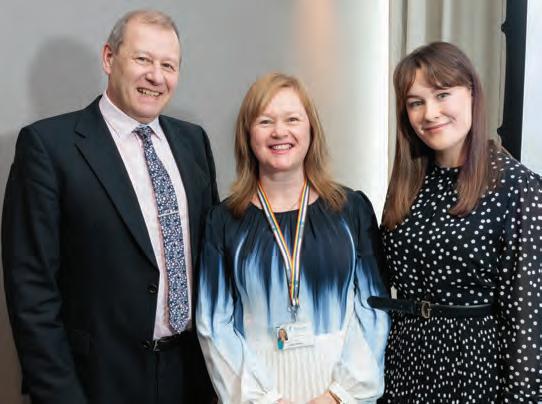







64 the Parchment
DSBA Property Seminar
Left: Aisling Barry, Hazel Ruane, Maeve O’Sullivan & Lisa Danso Far left: Susan O’Halloran & Sarah Sbano
Left: Catherine McGuinness & Edward Geoghegan Far left: Paul McGennis & Marissa O’Keeffe
Right: Sally Ann McCoy & Barry Murray Far right: Eoin Langford & Kelly McGann
Right: Robbie Ormond, Judith Christie & Katie O’Riordan Far right: Elaine Given, Marie Claire Long, & Deirdre Walsh


IF LIFE GIVES YOU LEMONS WE’RE HERE TO HELP Consult a Colleague now in total confidence Call us on 01 284 8484 All calls to the Consult A Colleague helpline are treated in the strictest confidence - there is no need to give a name or number. A confidential free service from the DSBA. www.consultacolleague.ie
CORT Software for Solicitors

CORT2019




Approved by the DSBA and licensed by the Law Society of Ireland to reproduce the Requisitions on Title
CORTBase Requisitions on Title
Case & Risk Management
Simple user interface and dedicated support line to help you maximise efficiency and productivity
CORTBase
Legal Accounts
Innovative design making this the easiest and the fastest legal accounts system available today
Innovative - Affordable - Reliable
01 683 1927
cort@cortsite.com
www.cortsite.com
























 John Geary jvgeary@gmail.com
John Geary jvgeary@gmail.com




























































































































































































